My Diner with Andre 🔗
1981 • USA • Louis Malle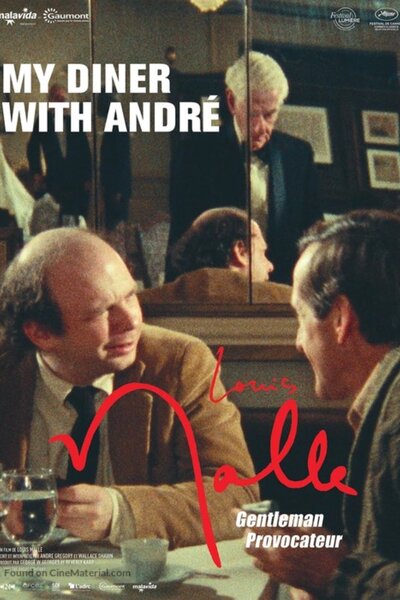
A pleasant philosophical movie about the late-capitalist post-modern
era and its existentialists dilemmas. A common subject that is brought
to light.
The story follows Wallace aka Wally, as he walks around and takes the
subway to meet a long time friend, Andre, for diner. He recounts a bit of
his life and what he knows of Andre in his inner monologue while traveling
to get to the restaurant. The center piece of the movie then rotates
around the conversation between Wally and Andre.
We're presented with two radically different persona: Wally is a simple
man, trying to get by, he's down to earth, living day by day, and enjoying
the small comforts that modernity provides; Meanwhile, Andre is the most
talkative, probably because Wally is inquisitive, and Andre had a deep
episode of existential angst and confusion in which he reconsidered his
life and started looking for meaning through different rituals which
he saw as eye-opening method to free himself from the habits of life,
and to finally authentically connect with others.
The movie has three phases: Wally getting to the restaurant with his
inner monologue, the conversation with Andre, and Wally getting home
in taxi with his inner monologue. In the first few scenes, Wally is
presented to us in a shot that shows him as if he came out of the garbage,
and as he walks through a dirty city, this is strongly contrasted with
the restaurant Andre chose: a very fancy one, which also contrasts with
everything that Andre spoke about. The bulk of the movie is then dedicated
to the conversation between the two characters and the filming is typical:
shot-reverse-shot, along with focusing on reactions. We often get a few
reactions from the waiters too and ogling eyes. There's a simplicity to
it, which resonates with the conversation that says 'We don't need a trip
to Mount Everest to feel reality. Reality is uniform, it's irrelevant
wherever we are'. Everything should be enjoyed for what it is.
The main theme is obviously the philosophical constraints of modernity
and its coziness. We're faced with one person who's barely making it
day-to-day, and only has the time for the necessities of life, yet
enjoys the comfort he can get whenever he can. Meanwhile, we have someone
that is at ease monetarily and yet dreads comfort and modernity, someone
lost in anxiety and willing to sacrifice it all to find meaning. We're
left wondering if seeking such meaning is a luxury.
Many of the topics brought are those of George Orwell, Aldous Huxley, and
Heiddeger. While not explicitly mentioned, we hear about the definition
of Dasein, or 'presence', along with the concept of 'being-toward-death',
'if you experience fully you'd experience your own decay'. Andre talks of
a sort of out-of-body experience, seeing the world from a third person
point of view and putting himself into question, and seeing society
as a theatre with people doing method acting. He especially focuses on
a return to romanticism, meanwhile Wally is a realist and doesn't see
the point in that, favoring science and the good it can bring. Wally
still acknowledges that modernity can be alienating and the need for
alternatives and countercultures, ways for people to 'wake up' and not
focus only on their vicinities. The core of their argument is about what
'meaning' is, Wally agrees that even though modernity has comfort, one
shouldn't let themselves off the hook. Yet, they keep disagreeing about
what a life should be: Should it be full of purposes, goals, and actions,
which is the opinion of Wally, or should it be contemplative, spiritual,
and connecting, which is the opinion of Andre.
All and all, this is a wonderful film. It displays a great conversation,
without strawmans, and full of challenges. The essence of the film is
there, no need for special effects or big explosions.
The Phoenician Scheme 🔗
2025 • Germany/USA • Wes Anderson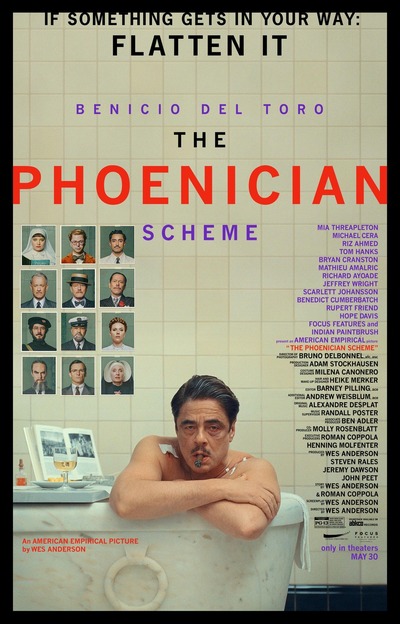
The phoenician scheme is a theatrical-style movie following a business
magnate trying to finish his dream project while staying afloat, even
while his multiple enemies get in the way.
Indeed, the core of the story centers around Anatole 'zsa-zsa' Korda
and the relationship with his daughter. The intrigue starts when worldwide
government officials manipulate the market and create a much bigger
'gap' in profitability than he had anticipated, thus he employs his only
daughter as his heir and enlist her to help him close the business gap
with his partners. However, as we'll see, the gap isn't only present in
his business life but also in his personal one, with his children and
brother. The one with his daughter, and indirectly his sons, get smaller,
while the one with his brother can never be filled.
As is usual with Wes Anderson, we have an assemble cast, the group that
gathers around zsa-zsa, like a magnet of personality. The story is mostly
from his perspective and we discover him through his interactions. He is
presented, on the opening scene, as an unfazed person, almost invincible
physically. Yet, this outer shell is only appearances, and through the
relationship with his daughter we discover his softer side.
Furthermore, as is also typical of Anderson's movies, we're presented
with a whole barrage of what he's become an expert at in his craft:
from symmetrical shots, with deep focus to show that even the background
decor is patterned and symmetrical, to well-polished witty dialogues
full of motifs and catchphrases. We also get the transitions and camera
movements that have become a hallmark of Anderson, the almost comical
dolly shots, along with his signature pastel tone but that is now
contrasted with a hollow black and white suspension when Anatole has
visions. The piece is split into multiple sections, similar to good ol'
cinema, which is used to create the pacing. Along with this we have a
beautifully crafted musical score.
The themes that the piece touches are ones of family relationship,
how the corporate world can interact and compete with nations, and
religion. However, I think that these weren't the main focus, and that
they took the second seat to the actual narrative architecture, or the
construction of this fictional-yet-relatable world.
One thing that kept popping into my mind is that these characters remind
me, probably too much, of Fantastic Mr.Fox, and that I've probably
felt more depth and feelings when this type of cinema style was done
over stop-motion rather than with real-actors. Regardless, it's still a
beautiful story, just in the way that only Wes Anderson can tell it. It's
a manner that feels like a children's picture book or bedtime tale, with
its own magical aspect and world building. Every frame, every twitch,
every trinkets, all is detailed to contain a world of its own and to keep
us in suspension in this alternate world. As perfect as this movie is,
one can wonder if it's not too perfect, and make us miss when things
weren't as serious, when they were more daring and innovative.
Hunger (Sult) 🔗
1966 • Denmark/Norway/Sweden • Henning Carlsen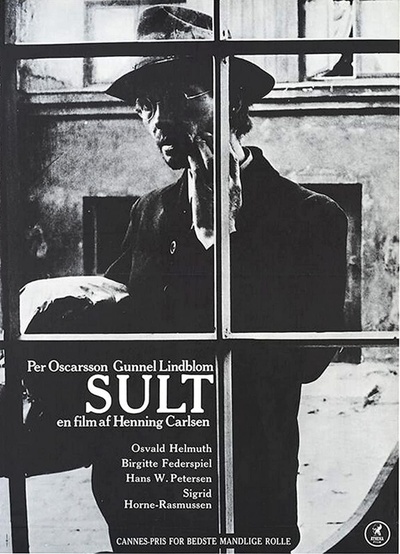
Sult is an introspection, a dive in the world of its Doestoevsky-like
'Notes from the Underground' type of character.
The story is established from the first few shots: We see a man looking
around, next to a body of water, trying to find inspiration for his
writing, yet cannot find it, and in sudden burst eats whatever he could
write. The message is clear, 'can I eat from my writing'. As we follow
this rather special character we start to see to which extent he's
willing to go to keep his pride and only reach his only goal to live as
a writer. Yet, in his pompous internal life, even though he's broke and
sells his stuff to a pawnbroker, he still helps the needy around him, yet
is self-destructive. But he still tries to maintain his outer appearances
and respectability. He even goes as far as biting his own fingers, eating
dust, biting on a bone, yet then suddenly feeling deep shame and stopping
instantly to get back on 'track'. His own restrictions and contradictions
creates a trap for his life, pushing him to physical extremes until he has
no place to stay and his vision becomes blurry from hunger, irrational,
nervous, and has spurs of anger. He truly feels that his only vocation
is writing, after so many other rejections. Even when he has the hope to
make it as a writer and that his lover accepts him, everything he's done
so far takes him away from it and makes him second guess. That is until
he completely gives up the idealism, at the end, and starts working as a
sailor, this is the only time he seems truly happy and smiles fully.
The story is a decrescendo, a descent into succumbing to things, but at
the same time trying to stay sane. There's a clear beat to this, as the
protagonist is often obsessed with clocks, as if his time will always run
out, it also reminds us that there's something he might have forgotten
and gives a pause to the story. This especially happens when the people
of the town know who he is and are being helpful indirectly by giving
him money, and later on he has to rationalize it, blaming them for their
indirect generosity, as if it's a mistake, that he can't be a beggar too,
since he's a writer. A key episode is the clash when he meets his ancient
friends who are successful, and feels as if he deserves this life, but
then right afterward meets a beggar on the street that used to work as a
metal worker. He tells him 'You are more deserving of money than me, you
are more qualified'. This depression is also expressed in the dichotomy in
how he sees himself, as a dog, or as a grand author, nothing in between,
no dilemma We see him dream of fighting with a dog for a bone.
As with most black and white movies, we focus more on characters and
story than the rest. However, the filming techniques are also impeccable,
with quick face closeup as the writer walks in the street, to show his
paranoia, or the dream like sequences where the colors are inverted,
showing the reverse of his daily life. There are also many beautiful
mise-en-scene with deep depth of field in which in the foreground we
see the writer, doing often something he feels ashamed of, and in the
background whoever he doesn't want to display himself to, a representation
of modern society. This gives the piece a humane feeling. Additionally,
the movie's score is a simple but eerie one, a few recurring notes
of piano.
There are many layers of tropes and themes tackled in Sult. From the dream
of making it in the city, to being stubborn and proud, or being blind to
reality when everyone abuses you, or the cynicism of keeping
appearance. There's also the obvious theme of hunger and what it leads
to and to what extent one is willing to give up food for their values,
and what it does to someone mentally.
The Name of the Rose 🔗
1986 • Italy/West Germany/France • Jean-Jacques Annaud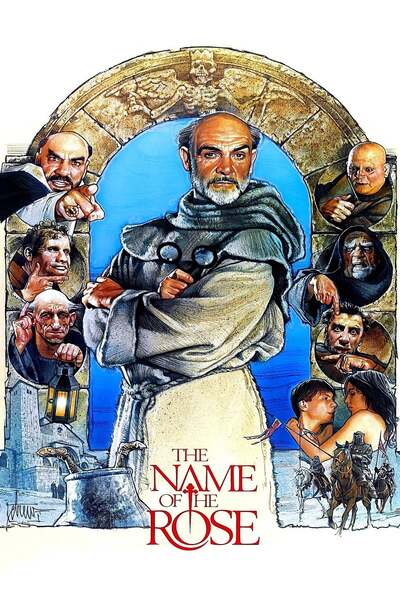
As Annaud puts it, this is a palimpsest of Umberto Eco's novel of the
same title, a re-interpretation.
It's presented as the subjective memories and narration of an older Adso,
which at the time was the apprentice, and friend, of a Franciscan friar
named William of Baskerville.
The acolytes are quickly introduced as having traveled across mountains
and the elements together to reach a Benedictine abbey in the north of
Italy in the Alps to attend a theological dispute. William is shown to
carry instruments, to be witty and highly intelligent, and to have an
acute and clear vision of the world around him. As the story progresses,
we see how his talents were also his doom in the past. Meanwhile, Adso is
initially mute, doesn't speak, and uneased by the situation he's in, yet
eager to learn. The first words he utters are 'I don't like this place',
to which his master uses calm and lucid logic to reassure him.
Around these two personages, we have the monks of the abbey, all
introduced as recluse observers, almost in a sneaky voyeur kind of
way. They watch from afar. Yet, none are as holy and pristine as they
want to portray, but argue about the minutiae of liturgy.
Meanwhile, this clashes with the serfs, the peasants, which are seen
and displayed as dirty, flesh-like creatures that are barely human,
violent, bloody brutes, ignoramus that can't contain their flesh and
temptations. Indeed, none talk or say anything in all the movie, they're
seen as animals, the only thing they do is laugh. The abbot refers
to them as his flock. The only one that seems to care about the peasants
are Adso and the Dulcinians: Salvatore and Remigio, they're the ones
pointing out that the church lives off of these people.
The story is centered around an intrigue: a monk died in a weird incident
at the abbey, and subsequent death happen. Like a detective, William
finds clues and investigate the killings. Meanwhile the monks panic
and imagine that this is the work of the devil and consider bringing an
inquisitioner to help. The intrigue builds up, and the relationship between
Adso and William grows. We discover that in the translators office,
the ancient monk Jorge hates laughter and wants to be the guardian of
the library, not allowing anyone to access it. Adso falls in love with
a peasant girl, William finds a labyrinth of knowledge, the aedificium,
and the mystery continues until the inquisition is brought in. As soon
as they arrive, logic is put to the side, wisdom dies, and only zealous
faith wins. Knowledge is burnt and only a few words can be saved, while
the monks argue about irrelevant details and the commoners pay the price.
The film is greyish, lacking colors, casting us in the fog of this remote
and austere abbey. The building stands as an ominous structure in the
back of many shots, some of them static and fixed on it, symbolizing
its weight and the meditative observation. Meanwhile, the nights are
swift and quick, it's where the masks fall and people put their faith
aside. Along with the tingling audio score, aerial landscape, we get a
gloomy vibe, giving us the feeling of being lost.
So many topics and motifs are present in the movie. It discusses the
relation of religion and austerity, apostolic poverty, along with the
inquisition. The tensions between Franciscan, Dulcinians, and other
views on it. It also asks deep questions about the role of institutional
religions towards the people, and how dogma and lack of tolerance or
understanding can cause pain. 'The step between ecstatic vision and
simple frenzy is all too brief, as William says. Furthermore, it plays
with conceptions of greek writings, techniques, and mythos; William
uses the Socratic method and brings forward dialectic. Additionally,
the scriveners, the translation institute, pushes around and tackles
the concept of knowledge preservation and knowledge discovery, along with
the idea of true authorship and plagiarism. As a semiotician, Umberto
Eco definitely introduced the intertextuality and intratextuality of
books here 'books always speak of other books, and every story tells a
story that has already been told'.
Did Annaud do justice to Eco: definitely. Would I recommend the movie:
it depends, the cinematography isn't extraordinary, but the topic is.
Fitzcarraldo 🔗
1982 • West Germany/Peru • Werner Herzog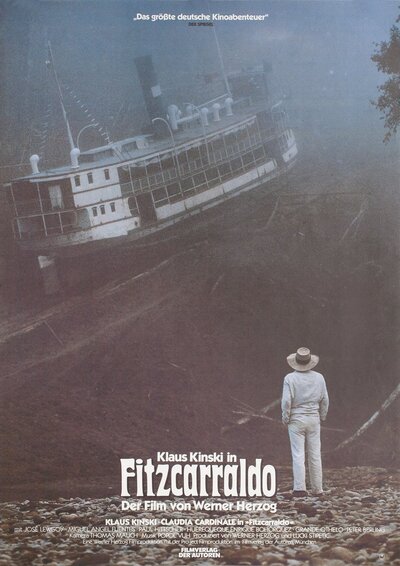
In between champagne opera and dangerously muddy infested water we follow
the story of Brian Fitzgerald, the Fitzcarraldo.
This is all about transporting us in the mind of the opera obsessed and
passionate character of Fitzcarraldo. He is introduced in the first
few shots as someone who goes to great length to get closer to his
dream, along with his loving partner that supports him in his crazy
endeavours. Indeed, we're told he traveled kilometers in the Amazon,
repaired his car on the way, got his hand injured, to assist to an opera
to which he didn't even book a ticket, yet through sheer will is able to
convince the doorman and attend. As the story rolls, and we get intimate
with his ways, we're cheering for his achievements, and frustrated by
his failures. A dream consumes and needs fuel. However, the beautiful
character development will eventually take him to appreciate more simple
things.
Rightfully so, the epic drama is split into distinct episodes that have
their own beats, just like a symphony. From the crashing introduction, to
the repeated failures and rejections, continuing to the exploding anger,
and ending the first part with a glimmer of hope and euphoria. The second
part is a slow and sluggish climb to a climax of happiness, and a steep
devastating obliteration coming back to a tranquil contented reality.
The camera work truly follows the rhythm and pace, from many upward look
at the beautiful opera houses, to the aerial or upper view, the montage
with Fitzcarraldo and his monstrous idea 'creation' in the back. The
white pristine clash of colors against the green and brown of the Amazon.
The message is clear from the beginning: This is a tale of men's
obsession with creation, a struggle to fight in a world that doesn't
accept us. The vision of lifting mountain and actually doing it,
achieving the impossible by sheer determination. This can also be seen
as a classic man against nature. Yet, a more beautiful subtle symbolism
is one of how life might know more than us what we need and take us to
different directions. We might keep asking 'why', but we'll only know
when we reach our destination.
This is the type of tropes we often hear, but I hadn't witnessed them
merge together and transcribed as perfectly as in this piece.
Nostos: The Return (Il Ritorno) 🔗
1989 • Italy • Franco Piavoli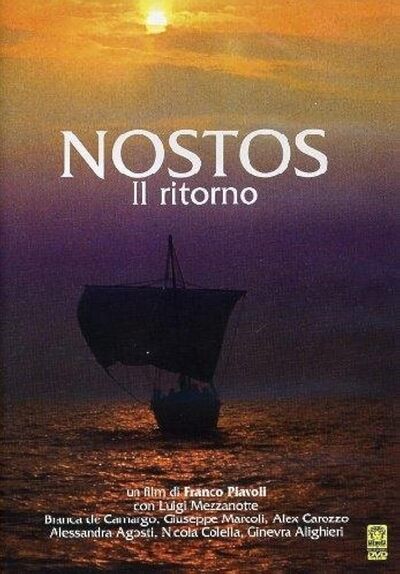
This is a pretty piece of art cinema. Every single frame and staging is
carefully placed, colored, and chosen to create an aesthetic, a stunning
tableau. There is no narrative, almost no interactions, the dialogues are
in ancient Greek and Roman, we're devoid of our habitual landmarks. Yet
it's in being forced to embrace the lacuna that we slowly fade into the
mind of the main character. All sequences are dream-like: we're being
constantly rocked by the rhythm of the sea, from its visual appeal, its
wrath, its treasures, and its different soundscape. This blank canvas
allows to inserts us in the soul of the ancient Mediterranean people, one
that was linked to the sea spirit, an era before maps where faraway lands
were only known by rumors and scriptures, a place where nature was above
humans and had a godly persona, violence and beauty reigning supreme.
All along the movie, we follow a single individual, one that is torn
by his past, that has lost everything, even his boat and all means
of transportation. He reminisces, is determined to move forward, to
let time roll, like is seen in the cuts in which a child plays with
a wheel, but he's only carried back home and never actually does it
purposefully. Indeed, There's an inherent notion and motif of the flow
of time, its continuity with the past and the impossibility to stop it,
yet of moving on regardless of obstacles. This is a tale of rebirth
and origins.
For me, this is one of the best executed piece of art ciné.
Seven 🔗
1995 • USA • David Fincher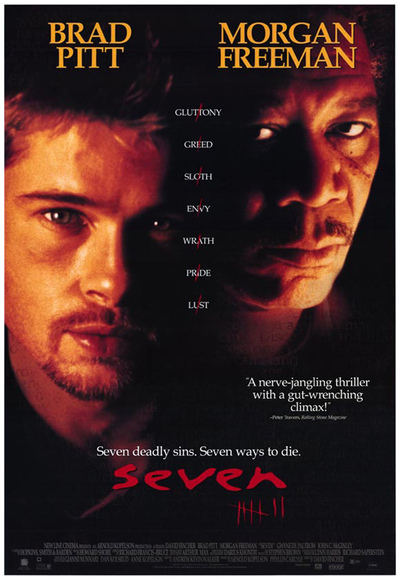
This movie is an exemplification of the film noir style and tradition
mixed with a psychological thriller. It includes a blend of the dark,
gritty, decaying and bleak urban atmosphere. Embedded in a world of
perpetual and inescapable rain, crimes, violence, and cynicism where
moral ambiguity reigns. The narrative unfolds from a third person,
voyeuristic perspective; we follow two detectives, William Somerset and
David Mills, on their quest to stop a serial killer bent on creating a
macabre 'masterpiece'.
The character development in this piece is meticulously crafted, it's the
most memorable aspect. Fincher relies on every element of cinematography
to introduce and evolve each character. Detective Somerset is portrayed
as deliberate and precise. In the first few scenes he's introduced in
his well-organized apartment, with the chessboard in the foreground —
a metaphor for his calculated nature. We also see his meticulously placed
objects on the table, and his reliance on a metronome to block the sound
of the chaotic world around him. This underscores his need for control,
apathy, weariness, or dissociation, in an uncontrollable city.
In contrast, Detective Mills is introduced with dynamic movement, bursting
into the scene by running up the stairs. He is youthful and eager to
get to the same level as his older peers, wanting to prove himself to
the more seasoned detective. As the narrative progresses, their
relationship is explored more deeply, and their visions of the world
clashes.
Looming behind, lies the persona of the serial killer, a third critical
character in this trio. His presence and personality is felt even before
he appears on the screen, he is anticipated and drawn in the minds. As
Somerset puts it in one scene 'don't idealize him, you might be letdown,
he's still human, don't think for a second we're facing Lucifer'
(paraphrasing). In sum, each character represents a philosophical battle.
There's a few key episodes that intertwine Somerset' and Mills'
investigative journeys along with their professional and personal
lives. The scene in which they search in parallel: Somerset is the
intellectual listening to classical music while getting clues from
books, while Mills is at home amid noise and relying on intuition and
energy. The scene uses cross-cutting to show the parallel between the two
methods, this editing also reveals that even though they use divergent
methods and had a negative start, that they'll eventually converge. The
intellectual proximity eventually leads to an emotional connection.
Somerset symbolically leaves his office for Mills, removing his name tag,
marking a subtle passing of the torch, as Mills begins to inhabit his
space while he fades in the background. Their bond strengthens further
when Mills' wife invites Somerset over for dinner, marking the first time
they truly connect on a personal level. Through careful framing, we can
admire the contrast between Mills’ messy but warm life, with dogs and
a wife, and Somerset’s solitary existence. Despite their differences,
the two men are beginning to find common ground.
This duality between the characters culminates in one of the film’s most
philosophical scene in which Somerset and Mills are at a bar. Somerset's
cynicism and Mills' idealism clash once more. The seasoned detective
argues that apathy is society's coping mechanism in a world rife with
violence and moral decay. Mills, however, cannot accept this and he
refuses to live in a place where apathy is a virtue. As with any film
noir, moral ambiguity is at the center and humans are seen as inherently
bad. Somerset’s cynicism is revealed not as indifference, but as a
form of self-preservation, a method to cope with the harsh realities
of the world. The conversation ultimately sparks a shift, when Somerset
later comes back home, in a symbolic act of breaking from his controlled
existence, he destroys his metronome, representing his willingness to
fight for the future, however futile it might seem, and to not let Mills
self-destroy in idealism.
The introduction of the serial killer, John Doe, marks a turning point
in the narrative. His initial appearance is underwhelming; with a name
as generic as 'John Doe', he's unimpressive, a visual contrast to the
monstrosity of his crimes. In a chilling scene towards the end of the
movie, he justifies his actions from behind the bars of the police car,
arguing that the people he killed were not innocents but societal
miscreants which horrible actions were ignored due to widespread
apathy. His belief that his horrible 'masterpiece' will bring more
clarity and meaning than police work exposes the warped philosophy
driving his actions. His manifesto not only reflects the nihilism of
the city Somerset despises but also serves as a distorted mirror to the
detectives' own struggles with morality and purpose. Each key plot
episode is meticulously crafted to build tension, develop character,
and delve deeper into the film’s exploration of human nature, evil,
and society’s complicity through indifference.
All the film techniques convey an atmosphere of tension and darkness. The
color palette is mainly dark with a greenish macabre tone. It is
constantly raining which is oppressive and enhances the sensation of
claustrophobia, of wanting to escape the city. Meanwhile, the use of
so many low-angle shots of the detective and police, tries to convey,
on one side, authority and stability, yet on the other all it performs
is make us even more sick of these people and how helpless they are. A
justice that is out of touch. The score, with tracks such as 'Closer to
God' by NiN offers an element of dark thematic, of raw animal passions
that need to be smothered. Lastly, there's a stark contrast that comes
in the final desert scenes. The rain stops and the sun emerges and burns
the ground. The scene is almost apocalyptic in its mise-en-scene, with
the high-tension electrical towers looming in the background and not a
human live in sight. It might imply that human presence itself blocks
any sense of purity or hope.
The film explores human society and its relationship to justice and evil.
One of the film’s most prominent themes is its reflection on Dante’s
Inferno, with the seven deadly sins serving as a framework for both
John Doe’s crimes and the detectives’ investigation. This descent
into a moral abyss mirrors Somerset and Mills’ journey as they grapple
with the nature of sin, justice, and redemption. The sins are not merely
symbolic; they are weaponized, forcing society to confront its own apathy
and complicity in allowing moral decay to fester.
John Doe can be seen as a non-standard form of vigilante, at least
from his own perspective. He sees himself as a nameless and faceless
embodiment of societal rot and as a self-appointed judge who believes that
what he does is needed to awaken society. He could be anyone, he *is*
society and will act and avenge instead of the impotent justice.
This rotates around the central theme of ambiguous morality and how to
judge someone's action. Is justice and societal order futile in such a
cynic and noir world? Should we rely on ethically dubious means, such
as he FBI tracking, to keep society in check? How far should we go to
keep order, and does the actions of Doe’s murders blur the line between
justice and sin. The city will stay an unchangeable and untameable beast,
can we tame the cycle of violence? The theme pits apathy, idealism,
and nihilism against one another.
This is a good movie, mainly because of its approach to character
development and the perfectly presented film noir interpretation.
Watchmen 🔗
2009 • USA • Zack Snyder
The Watchmen is a dark and dystopian alternative historical drama
with a mix of speculative fiction about the cliché American comic
superheroes. It is set in 80s America, specifically in 1985, at the height
of the Cold War and paranoia about an impending cataclysmic nuclear
doomsday. The story follows a set of forcedly retired costumed heroes,
which in reality are masked vigilantes, whose 'job' got obsolete after a
'real' superhero replaced them and started working for the government:
Dr.Manhattan. The plot starts as an old hero is assassinated, and
Rorschach, an unyielding vigilante that reluctantly didn't want to retire,
tries to uncover the conspiracy behind the act, which leads to an all
encompassing deadly event.
The narrative style is non-linear, it heavily relies on flashbacks to get
us acquainted with each character's backstory and connect them to the
overarching mystery. Furthermore, the story is often portrayed through
Rorschach's voice, as we hear his inner monologue, his diary entries,
giving a sort of neo-noir detective tone to the story. Additionally,
the transition between events are often intersected with a cartoon
interlude called the Black Freighter, a gory and gruesome tale about
pirates, their delusion and inevitable self-destruction. This type of
heterogeneous approach to story building makes it a unique and complex
piece, however it may alienate viewers that are not familiar with the
material or impatient.
Undoubtedly, the core of the movie revolves around its characters and how
they fit within their environment. The film starts with a kaleidoscopic
intro spanning from the 40s to mid 80s, showing all major American
historical events from the assassination of Kennedy, the Vietnam war
(won with the help of Dr.Manhattan), the 60s hippies stopped with the
help of heroes, Warhol making pieces about heroes instead of Monroe,
a man walking on the moon, all leading to the retirement of heroes and
Dr.Manhattan's job at being a nuclear deterrent. Each hero is given
their screen time and moment so that the viewer explore their inner
world.
The Comedian, with its iconic bloody smiley face, a motif in the movie,
sees the world as a joke. He's the embodiment of nihilism, cynicism,
and brutality. His laughter brings his death.
Meanwhile, Rorschach is a moral absolutist that will never compromise
against what he perceives as evil. He's the only hero that didn't retire
and didn't reveal his identity because he feels he has moral retribution,
believing that 'once a man has seen the dark underside of society, they
can't pretend anymore'. His diary forms the backbone of the story, and
his face, a literal blot test, as his name implies, also adds to the idea
that it's the viewer that decides how his actions are perceived.
Another character is Nite Owl, a hero that is seen as nostalgia of a
better era, living in the past, literally feeling impotent about the
world and himself. We perceive this through a scene in which he walks
away from the house of his friend which is a retired car repairmen,
specializing in 'obsolete models', even the ads say 'Nostalgia' as he
walks under the rain with the camera angle from above, as if defeated. He
only regains a sense of being himself when he puts back his costume, yet
he knows that it's not his place anymore in this world.
The character of Ozymandias stands on the opposite of the others,
he is a rich, successful, and hopeful idealist, seeing himself as the
savior of humanity. However, his vision is based on an extreme form of
utilitarianism that wants to make war obsolete regardless of the means
and casualties.
Dr.Manhattan is the only real hero that has powers, being immortal,
shaping matter at will, and seeing his own past and future. He gain his
super powers after working as a nuclear scientist and getting into an
accident. Yet, his power and abilities pushes him away from his humanity,
distancing himself from what he sees as trifling matters, which also
ruins his personal relationship. He is less human and midway through
the movie actually gives up entirely on humans. However, the rest of
the world see him with either with hope or fear, he acts as a sort of
omnipotent godly figure.
Lastly, the Silk Specter II is a hero that has an identity crisis,
struggling and torn between her relationship with Dr.Manhattan and
Nite Owl, while discovering the truth about her mother and her real
father. She's sees all aspects of what it means to be a hero and what
it means to have internal insecurities but still not give up on life.
All of the episodes and sequences are set in a way so that we slowly see
and build an opinion about what type of peace we want and if it's right
to have vigilantism, self-righteous masked heroes. We learn indirectly
about how unclean it can be, about the horrible sides of humanity,
imbalances, the idealism, and messy relationships. For example, at the
psychiatrist scene with Rorschach that shows him the ink blot we are
there wondering about what we should see. At each step we think we can
take a breather with the pirate tale, but it constantly pushes us to
despair. Each scene is full of tiny details that keeps remind us of this
such as the protesters with graffiti or posters saying 'no vigilantes,
badges not masks', or the American flag with 'who watches the watchmen',
etc.. There's this constant nauseating feeling across the piece that
time is running out.
The movie has this dark distinctive tone, almost grainy and oppressive
atmosphere. Everything is submerged in rain, shadow, night, with a dark
tone, black transitions or match cuts. In the opening scene we get a
diegetic music from the television, as if seeing things through media
while reality is different. This is confirmed with the type of Dolly
zoom employed and the slow zoom in to characters, and then zoom out from
the city, giving a sense of a larger distant and more important scale of
things. The camera only does a zoom in from a wide shot of the city when
the movie is about to end, showing that now we get it. Obviously, fight
scenes have quick cuts, but they're not predominant. The Black Freighter
story is a cartoon, in clear contrast to the main story line, a fiction
within a fiction by relying on pirates instead of superheroes.
At its core, Watchmen wrestle with the idea of justice in a morally
gray world. Who is right, who is wrong, and how can we keep the world
in peace. Each character offers their own version of justice, letting
us ponder on it, being the judge of their action. Yet, the vision of the
world is a gloomy one, humans are seen as hopeless, and we see it through
the art of their world such as the Black Freighter that is a macabre
perception of humanity and its delusion, or through the bloody smiley
face of nihilism and cynicism. Is this all a joke? The story emphasize
that noble intentions can lead to atrocities, but that atrocities might
be needed to keep humanity in check. This arks back to the idea of
the philosophical Leviathan by Hobes in the domain of political social
contracts. On the question of whether humans are good by nature, this
film clearly says they aren't and has a horrible view of what humanity
is. Indeed, this can be understood as this was written during the height
of the Cold War paranoia. We can also see the omnipresent motif of
the clock and time. The clock represents humanity's ability to destroy
itself, a reminder of the doomsday clock for example. The MinuteMen, the
old heroes, were replaced by the WatchMen, that carry time with them,
always looking at it. When the WatchMen retire, they can only rely on
Dr.Manhattan who only see the clock as relative, his clock is already
stopped at midnight. For him, everything is set in stone already, and
cannot be changed. 'Who watches the watchmen' can be interpreted as 'who
keeps in check the justice system', or 'who keeps in check this system
that avoids our total destruction'. The movie ends with Dr.Manhattan
being elevated as a super Leviathan figure, a sort of God-like persona
that monitors the world, the deterrence system for the deterrence system.
All and all, this is a complex piece that let us thinker about justice,
destruction, morality, and humanity. It is well executed!
Eternity and a Day (Μια αιωνιότητα και μια μέρα) 🔗
1998 • Greece • Theo Angelopoulos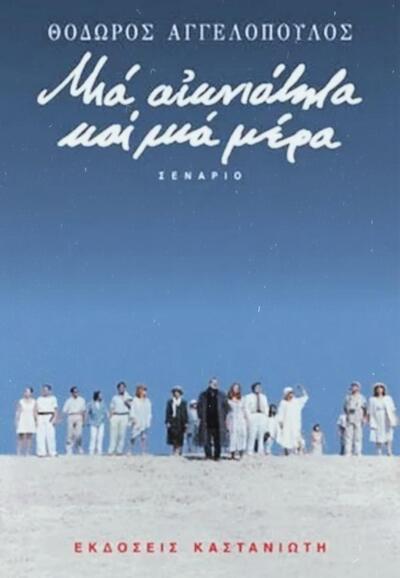
This is a poetic and poignant piece of cinema centered around an
old writer and poet, Alexandros, who finds he is terminally ill and
has only one day left to live. The narrative is delicate, we aren't
directly told anything, but indirectly learn things through the sparse,
yet powerful dialogue. We're invited to piece together the impending
fate. We follow him on his last day as he tries to get closure, meditate
on fragments of his life, leave things behind, and pays a last visit to
the people he cares about. Somehow, on this last day, he finds vigor
in helping a young boy who escaped from Albania to work in the streets
of Greece as a squeegee within a gang. The boy gets in trouble and is
almost sold by human traffickers. Hopefully, he is rescued from the
clandestine operation by Alexandros. It revitalizes the old man and he
finds solace and companionship in this lost child. Meanwhile, as he
visits his daughter he learns that their beach house, which he holds
dear with memories, is getting sold, and when he visits his mother she
is incapable of speaking nor understands what he says. Yet, he never
tells anyone his true fate. With his young companion, they both mourn
for different reasons, both leaving to somewhere, both saying goodbye
and moving on. The boy departs on a ship in the middle of the night
to an unknown destination, and on his way back Alexandros is deeply
pensive. He finally decides he will end his day at the beach house. He
accepts his fate, won't seek medical intervention, but rather will rejoin
with his wife in the afterlife. As she used to say, 'tomorrow will last
an eternity and a day'. The way in which this is all narrated touches
the essence of our soul, a somewhat affectionate mourning.
The main character we're following is Alexandros, which we come to
understand through the eyes of the others and his introspections that
are done via his reading of his wife's poems. Additionally, his vision
of the world slowly seeps and percolates through the narrative as if his
imagination becomes reality in a surreal experience. His interaction with
others, mainly the squeegee boy get us to know him. One of the boy's
line truly encapsulates this bittersweet mood: 'You smile but I can
still see your pain through it'.
There's a lot of key episodes and elements that help keep the beat of the
movie, a deliberate and slow pacing. The day goes by but somehow it seems
eternal, timeless because of the very long shots. One of the mesmerizing
moment is the final bus scenes in which everything moves forward. There
are cyclists in the rain, like the cycle of life, moving regardless of the
weather. People coming on and off the bus, each with their hurdles. Also,
there's the vision of the ancient poet that Alexandros was working on
but just couldn't find the words to properly do him justice. This acts
as a metaphor for life, time passing, people simply being people.
The whole film has a masterfully crafted smokey undertone, a poetic
vibe. This is achieved with the long shot that let us simmer and
linger in each moment, letting us completely immerse ourselves in the
emotions. Even the last bus scene mentioned above employs a beautiful
technique of reverse tracking shot, giving a sensation of distance even
though it's in a confined space. We're seeing how life, even though short,
can be grandiose and appreciated, with its in and out. Furthermore,
long shots let us appreciate the fantastic mise-en-scene which are almost
like paintings. Every single frame is a beautiful piece of art. We're
there to admire each moment of Alexandros last day, everything takes a
new meaning. It is both eternal and immediate. The score is melodramatic
with some accordion and violin which often emerges as diegetic music,
blending with the surrounding scene, people holding instruments or
singing. In the same vein, everything flows from Alexandros, there's
no cutting frame to lead way to his reveries, instead his flashbacks
seamlessly morph into the present reality.
There's a lot of beautiful themes that this film caresses. It dives into
the subjectivity of one's life, its inevitable ending, how it slips away
with its regrets and unspoken words; words that are so costly to find. It
leaves us with a lot of questions such as whether we can truly express
ourselves if not through others' words, what it means to live and embrace
the day, how to accept the unalterable passage of time. Furthermore,
it always discusses the idea of traveling, of leaving and accepting
it. Despite Alexandros's sorrow and regrets, he remains open to the
world and its meaning in the most unexpected places. This masterpiece,
its profound storytelling, leaves a mark as a powerful metaphor that
resonates with the passion of life and humanity.
little miss sunshine 🔗
2006 • USA • Jonathan Dayton & Valerie Faris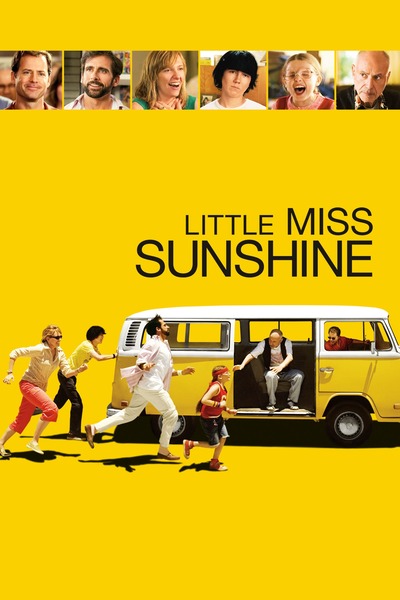
A story following a somewhat dysfunctional family on a journey to push the
dream of their youngest member: Olive. At its core, the narrative rotates
an around the ensemble of 6 characters, each of whom undergoes gradual development
during the film. They have their own aspirations and inner turmoils. Yet,
there's a clear distinction between the 4 adults, 1 young-adult, and the
child. The adults are protective of how life could harm Olive, trying to
teach her directly or indirectly how to fend for herself. Each person
doing it in their own ways, slowly opening up. It is apparent that the
adults have coping mechanisms because of the hardship of life, through
their minute actions and reactions. Each role is played perfectly, and
the directors beautifully achieved this challenge of equally giving
weight and presenting their inner woes and letting us connect with all
characters. The chemistry among the cast is evident from the outset,
with glances and interactions that feel genuine and spontaneous.
The key episodes in the movie are woven around individual characters
facing a hurdle, a challenge, and overcoming it or having it reveal
another layer of themselves. There's a specific beat to the story,
as they're physically moving in an old broken van towards California,
each obstacle along the way serves not only as a plot device but as a
catalyst for bringing the family closer together. There's a recurring
motif of rhythmic music that underscores the scenes in which they run
along the van and push it. The music halts abruptly as they reenter the
vehicle, as if all are suddenly part of a single organism, united in
their experience. No one gets left behind.
There's a reminder of this in the scene where they stop at the gas
station and almost forgot Olive. Another shows the epitome of this
concept when Dwayne learns that he's color blind and has a crisis,
there's a shot where Olive gently hugs him while the rest of the family
is watching from behind, next to the van, signaling that they're in
this together. Similarly, there are many Chekhov's gun employed across
the film that suddenly make opportune appearance later in the movie,
such as with the grandpa's magazine, or the dad emphasizing the winner
mindset to never apologize which pivots to him getting on his knees
towards the end.
Visually, the film shows true contrast. The bright color palette and
enthusiastic score are a sharp juxtaposition to the themes the film is
exploring. This instantly encapsulate what this is about, childhood vs
adulthood, family life. Most of the scenes are often subtle about it,
focusing on upper body and close-ups, letting the actor's facial
expressions carry the narrative, which they wonderfully do. There are
also multiple dirty shots and mise-en-scene with objects around that
act as fillers or signifiers, adding context. Such as the medals and
trophy in the background when the parents are deciding whether to go
to the beauty pageant contest or not. Additionally, group shots are
another technical highlight. There are plenty of 5-6 shots, including all
members of the family, be it with some in the background deliberately
out of focus creating a layered visual, or all in the foreground.
While the ideas are not groundbreaking, the execution is still
exceptionally well done. The film touches the concept that a family
is composed of diverse people with various and often contradicting
passions and personal issues, but still somewhat in this dysfunctional
setup become more compassionate with each others, closer. It also
dives into the related idea of life after failure, of the judgement
and harshness of society and how to navigate it. Everybody pretends to
be normal, yet no one is perfect. The adults are shielding the cocoon of
childhood that is full of magic and dreams and simultaneously trying to
foster her growth. There's a continual subtle irony that they're going to
a beauty contest, an event that is based in shallowness and appearances,
which often equates with the expectations of society. There are always
better people, yet life can be enjoyed, it doesn't mean we have to uphold
ourselves to standards that are hurting. Ultimately, imperfection are
part of life, and life moves on.
The Good, the Bad and the Ugly (Il buono, il brutto, il cattivo) 🔗
1966 • Italy • Sergio Leone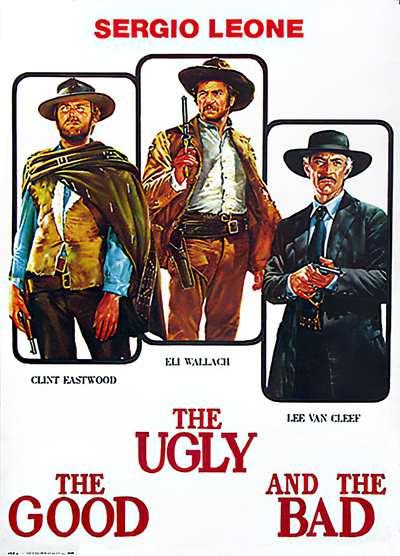
This is the renown epic spaghetti Western that everyone pictures when
they think of the genre. Action packed, violent, lots of deserts, horses,
and guns, it definitely delivers. As usual it's a story that rotates
around bounty-hunters/mercenaries/bandits in a free-for-all lawless
region of the USA. The twist is that it takes place during the American
Civil War and follows not one but three bounty-hunters.
The movie centers on the trio who inadvertently have their fate
intertwined in a common treasure quest. It is their diverse personalities
that attracts us and makes it interesting. The first, the ugly named Tuco,
is introduced through a silent scene in which three bounty hunters try
to tackle him in a house while he is eating. He quickly shoots them and
jumps from the window. Tuco is the most emotional and talkative character
of the movie. He is lighter than the other characters, more easy going,
yet resilient and resourceful. He's shown to have extremely fast and
precise shooting skills all across the movie, yet is also shown to be
unlucky with the guns he picks. It is the only character that has
development and a back story, hence the viewer is indirectly following
the story through him.
The second character introduced is a well-feared man, Angle Eyes as they
call him, the bad. It is a meticulous and dogged man, that is also true
to his words to a fearful degree. In his introduction scene, he doesn't
hesitate to liquidate a family for the bounty of 500 dollars, yet the
father of that family had pleaded him to kill back the one who asked him
to do this for a bigger sum, 1000 dollars. Angel never refuses a job,
yet he still kills the family, and when he comes back to the one who had
hired him, also kills him since he always fulfills the job, even if it
include assassination. This is the only character whose shooting skills
is not truly shown, probably because he isn't as good as the other two,
as is discovered later in the movie.
The last character introduced is Blondie, the good. He is a confident
and stoic character, who tries to make money through a scheme in which
he brings wanted bandits to a town sheriff, waits for the bandit to
almost be hanged, and just before they let them fall to their death, he
shoots the chord from afar to release them. He repeats this tactic again,
partnering with the bandit, when the bounty on his head increases. His
sharpshooting skills are instantly recognized by the viewers. This is
what brings Blondie and Tuco together.
Indeed, the plot heartbeat is all about the slow and continuous merging
of these characters. There's a few key moments to this. It initially
starts with the bad being obsessed about chasing a patched-eye man. Angel
eye at this point is the only one aware of the treasure the man knows
about. Meanwhile, Blondie and Tuco have an on-and-off ambivalent
partnership to make money. When Tuco takes revenge and carries Blondie
through the desert, this is where he encounters the famous patched-eye
man. However, he is in a caravan dying along with other men, he can
utter a few words about the treasure to Tuco, yet as Tuco brings him
water he dies and only Blondie hears the end of the location where the
Confederate gold treasure is. One knows in which cemetery it is and the
other which particular tomb it is hidden in. As they go on a quest
towards the treasure they get caught by the Union, and meet The Bad,
which seems to already know Tuco. The link between the character is done
and the treasure hunts with its fights ensues. At each point the tone
is about character relationship and its tension, at each key step bringing
them closer.
The camera work in the film is amazing, it's the epitome of Westerns
style movies. It encompasses the them of dry deserts, folk torn cities,
never-ending pastures, mountains, and the immensity of travel through
them via multiple aerial shots. The transitions are almost always fades,
reminding that the travel distances are long. There are the countless
eye-level zoom shots and hands-at-the-belt shot, or the quick cuts from
eye-line to eye-line, or even rotationally shot to show all eyes. The
classic stylised and super-dense gun fight scenes. In other gun shooting
scenes that are more minor, the view is from the back, dirty shots showing
the adversary. Additionally, there's even more power dynamic shown with
the high and low angles, showing height difference between people when
one is more aggressive than the other, pure intimidation. Along with
all this, we have a beautiful Western style music and sound effects.
There's a few recurring themes in this piece. The main one is a critic
or hate of war. The trio is distant to whatever is happening between
the two camps during the war, yet also sometimes have to mingle with
them to continue on their path. They're still dismayed by the horrors
generated by it, even Angel Eye, which was seen as more cruel than Tuco
and Blondie, is shocked by what he sees. It seems like a commentary on
the uselessness of war. Another theme touched is greed and how it can grow
in a lawless place, dizzying and captivating. The trio is literally on a
'gold-rush'. Maybe it's also a hint at war, at the opportunistic people
that only think of money to make from it. However, the movie has a hard
time passing that message, what it appears like is more of a Western
version of Pirates of the Caribbean.
Definitely a must-watch!
Amerikatsi (Ամերիկացի) 🔗
2022 • Armenia • Michael A. Goorjian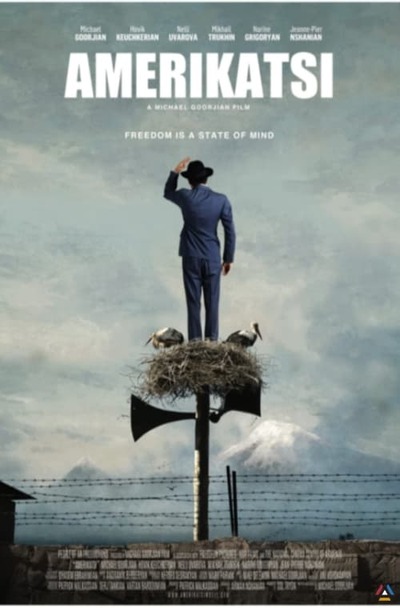
Amerikatsi is a story set in Soviet-Armenia, post WWII, in a phase
when Stalin installed a few puppets around the URSS that filled
useless quotas. During that time, Armenian were incentivized to go
back home, repatriation. In Amerikatsi, we follow one such person,
an Armenian-American called Charlie Bakhchinyan, whose family got
killed during the Armenian genocide, and whose wife recently died in
New York. He goes to Armenia as a last resource, to find his roots,
which often come back to him when he dreams of his mother telling him
to fly like a stork. Somehow, he ends up in a messy situation where the
husband of a woman he helped sell him as a prisoner to fill the quota
of the city, under the useless and absurd pretense that he's spreading
capitalistic, imperialistic, and bourgeoisie values by wearing a tie. When
in prison, and because he's not fluent in Armenian, he finally realize
what is happening and his baseless sentence. In the next few days,
in the prison court, he tries to argue his case, but the guards refuse
to answer back and instead tell him he'll be assign to Siberia. Yet,
as they say that an earthquake start and the wall of the prison falls,
the nest of stork that was perched on a pole also falls but Charlie
is able to catch it's egg. Somewhat, all the prisoners stay there to
rebuild the wall. After the fall, from Charlie's prison cell, in solitary
confinement, he can now see from the window the house of a family,
which he soon discovers is the house of the guard of the prison who
used to be an artist. Then ensues an indirect complicity between these
two characters, the watch guard, like a stork watches over him while in
prison, meanwhile he watches over the house of the guard like an angel
and follows his day to day life as his entertainment. Charlie learns
everything about Armenian culture from his days looking at his
window. After a few months, when the wall is finally built, and the
stork from the egg has grown, things somehow fall into place again and
Charlie is liberated from his fake imprisonment. The movie ends with
Charlie walking through the house of the guard, who had left it to go
back to his artist roots.
The character of Charlie is shown as strong, almost stoic in face of
adversity. His charisma and optimism is inebriating. It is shown through
his smile, his mannerism, his actions and body language.
While the film is shot in a mostly dark tone, it is contrasted with the
implicit monologue of Charlie and the uplifting Armenian songs that
are heard throughout. The piece also perfected the art of the dirty
shot, almost in a voyeur kind of way, beautiful compositions with the
obstruction of the cell window bars. This emphasizes the idea that we're
seeing things as the prisoner, yet as the movie progresses we can feel
the physical distance between the artist that is forced to be a guard
and Charlie.
There's a lot of key episodes in this movie. From the wall falling,
as a representation of the facade that the soviet put in front of the
'real' Armenia, a word that the prisoners often mention. The wall falling
allows to see the way Armenian live on a day to day, especially also the
mask they put. For example, the tower guard turned out to be a repressed
artist who used to love painting churches and mountains but was forced
to never paint again and instead work for the Party. Everyone is playing
a game. Another key episode is the one with the symbol of the stork,
from the dreams of his mother telling him to fly away, from the stork
egg that fell and then grew toward the end of the movie to actually fly
away, going back to the roots or being born again, and the similarity
with angels and tower guards, each having insights in the life of the
other. How opposites can often synchronize even in the worst kind of
situation. Definitely, the tale is also about hope and survival, about
stoicism and resilience.
Anatomie d'une Chute 🔗
2023 • France • Justine Triet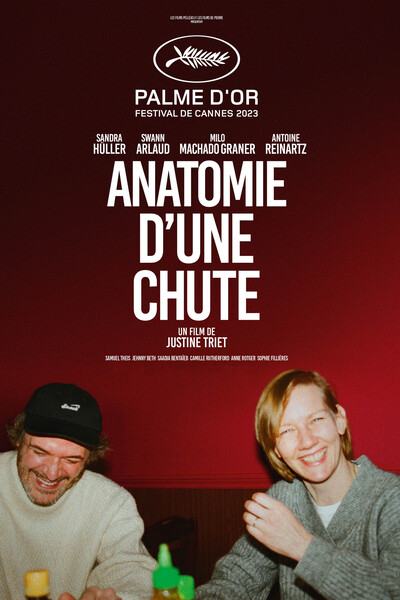
The anatomy of a fall is a court drama rotating around the death of the
husband of a famous writer. The man, who was working in the attic, and
had music blasting while his wife was meeting with a student interviewing
her, and whose vision-impaired son was simultaneously having a walk with
their dog, is subsequently found dead after a fall. Then ensues a
court case to uncover whether the man's death was a murder, suicide,
or accident.
The story emphasizes the point of view of the child, in-between the
arguments of the parents recounted in court, the judicial system, and
a gust of different emotions.
We're presented with the characters present in the family, the child,
the parents, but the father, being dead, is only represented through
memories. Meanwhile, we also have the court players: The lawyers. The
court is the one setting the pace on how we imagine each person, in
one scene we can picture the wife as a cold, egotistical, and heartless
person, in another we can see her as understanding and loving. Similarly,
for the husband, we might see him as jealous, conflicted, and eaten
by guilt, or as paranoid and manipulating. The child, figuratively and
physically blind, is carrying some light on the situation. Yet, the most
evident is that lawyers can shape characters in whatever way that suits
their case. As the movie progresses, the rhythm and beat of arguments
makes us constantly frustrated with the legal system that saps everyone
of their humanity.
This is shown through a couple of important plot points. One where the
contract, and price of the lawyer is displayed in a focused shot. Another
where they celebrate since it's the first time they win. Or yet the
redundant speeches where the lawyer mentions that the truth isn't
important in a case but only appearances.
A lot of beautiful techniques have been employed in this piece. From
the character tracking, of both the dog after the death, or behind the
mother as she climbs up the stairs. Furthermore, emotions are emphasized
with shallow focus and facial shots. There's also a lot of play with
the courtroom scenes, different character positions, mise-en-scene,
and dramatization. For instance, there's a mesmerizing scene during the
defense in which the child is giving his testimony and the shot is
centered on him, but the people speaking are the competing lawyers
sitting on opposite sides, we see him looking left, then right, then left,
as if they were in a ping-pong match. With this, the musical theme is an
intimate one, a diegetic motif played by the son, Daniel, on the piano,
a Prélude no 4 of Chopin.
There are many themes in Anatomy of a fall. Indeed, the title itself
doesn't only refer to the dichotomy and analysis of the fall from the
window, but also to how many interpretations and angles it can be viewed
with, the chaos of the courtroom. Additionally, it also refers to the
fall of a family life, it's problems, and how it led to the mental fall
(suicide) of a man. Definitely, this movie talks of the tensions that
can happen in relationships, the dilemma and imbalances between liberty
and equality, the existential tensions and life paths. I'll leave the
rest up to the viewer to judge.
Overall, this movie deserves a watch, it's a memorable one.
Zorba the Greek (Αλέξης Ζορμπάς) 🔗
1964 • USA/Greece • Michael Cacoyannis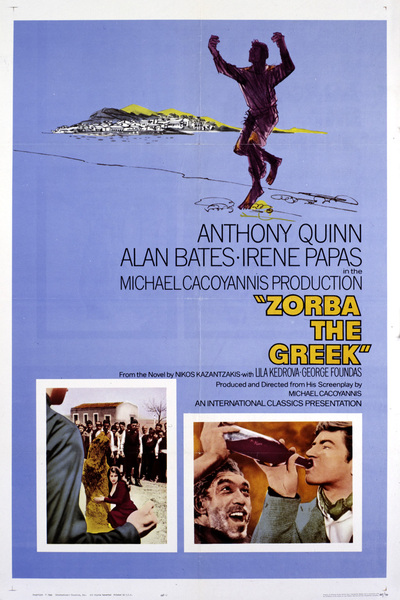
This is the story of a British born, half-greek, named Basil, who wants
to go back to a land in a poor impoverished village on the Crete island
that was passed down to him by his ancestor. On this island, there is
a lignite mine, which he hopes to revive. The plot starts with him
waiting for the ferry to the island, which has been delayed because
of a storm. With happenstance, an outgoing fellow named Alexis Zorba,
accost him and propose to join him in his ordeal since he has experience
in the mining industry. Zorba turns out to be an extreme optimists but
also a bit manipulative and egotistic. Zorba takes the lead at the mine
and devises a plan, a huge enterprise, to transport the wood beams from
the monastery forest, above, to the mine near the coast. In the meantime,
the life in the village is disastrous and for Basil and Zorba it revolves
around two women: The former French cabaret host of their hotel madame
Hortense, which falls in love with Zorba, and a widowed woman that is
despised by the whole village because she's not returning the love of
anyone yet fell in love with Basil. This culminates in a young man
committing suicide after learning that the widow has fallen for Basil,
and the village taking barbarous revenge against her, along with Hortense
falling ill and subsequently dying in Zorba's arms, while the village
elderly women invade her hotel and expectantly hope for her to die,
which she eventually does. Afterward, the whole village pillage, ransack,
and steal everything from her hotel. Zorba explains to Basil that these
villagers won't give her a funeral since she's 'frank', but implies
he'll do what he can to do it in secret. Finally, Zorba has his
contraption to take the lugs built, comes the day to test it and it
culminates in a monumental failure. The villagers run away and leave
both protagonists alone. They don't utter a word, instead go to eat on
the beach, laugh and dance.
Most of the narrative is centered around the two main characters, their
contrast, views, and how they fit in their new environment. Basil is a
recluse bookworm, writer, who has never been married and tacit in his
approach with people. Meanwhile Zorba is boastful and electric, with an
extreme optimism that is infectious, life-affirming, with witty remarks,
often egotistical and manipulative, but mostly because of his forwardness
about things. Yet both are trustful of human nature, compassionate
and loving persons, hence both get truly hurt by their adventure on
the island.
The beat of the scenes in this movie are intense, there's a rhythm
to them that is rarely achieved in other work. From the dance scenes,
to the barbarism, and to the epic climax of the crash.
To achieve this, all the camera tricks in the book at beautifully
used. From rotating staging, to reaction shots. We also have the
introduction to environment through deep depth of field superposing
foreground and background, along with upbeat scenes that are full of jump
cuts and dynamism, to the chiaroscuro of the first Zorba dance where he
opens up like a bird, with arms wide open to life. We're entranced by
the composition of greek-like melodies, often joyful, but also immersed
in the background to portray sadness or intensity.
The themes this piece touch is a hard one: what's the best way to live
life and how to handle its pain. The ephemerality of life is the recurring
motif, constantly reminded throughout the movie. Zorba embodies an
embrace to life as it comes, going forward front facing everything. 'Life
is about asking for trouble!', 'They say that age kills the fire inside a
man's heart. That he opens a door and say just come in give me rest. That
is a pack of old damn lies. I got enough fight in me to devour the
world. So I fight!.' And Zorba literally fight against nature, a whole
mountain. Meanwhile when he gives advices to Basil it's with words such
as 'I understand you're young and full of energy, and I don't understand
the hell you're doing with it.' On the other side we see the madame
of the hotel wishing to be young again. And we hear of time with Basil
giving ultimatums to Zorba. To accompany this fleeting feeling, it seems
that the village is a metaphor for what they can't control. They seemed
to be imposed their barbaric customs, and are hopeless about it. From
the killing of the widow to the lack of funeral of Hortense and the
ransack of her hotel. Yet they don't overtly hold grudges, blame them, or
give any remarks on it, it's as if the villagers weren't subjects to their
own actions, human beasts, animals in a passing world. Sort of like the
weather, they can't do anything about it, yet we as viewers come to
hate them. Zorba has a philosophical approach to it which he shares
when Basil asks him about his idea on Turks, to which he replies that
he doesn't care about nationality, yet has done more than anyone for
his country but that in the end good or bad, we're all going to die, but
that it's better to be good regardless of origins, to not judge or keep
the hatred of war. Yet, such village that indeed held a grudge against
Turks apparently still kept it's ottoman style clothes and practices.
Most of all, this movie talks about how to manage repressed feelings,
be it pain, anger, or joy, when living in a senseless world. As Zorba
puts it 'When a man is full what can he do but burst.' As he recollects,
dancing is his way to process his emotions, he started after the death
of his child Dimitry, even if everyone thought him crazy. When he
questions Basil about his way to process his pain vis-a-vis death,
'why does anybody die. What's the use of all the books if they don't
tell you that.' Basil replies that it talks of the agony of men who
can't answer these types of questions, but Zorba rejects this and spits
on this agony and instead prefers to bursts into something physical:
a dance. His style of dance is an embrace, with arms wide open into the
light, and rotating and moving in syncopated steps. The movie ends on this
note, Basil finds an appreciation in this way of processing emotions,
and asks him to teach him to dance. Zorba summarize it perfectly 'You
got everything except one thing: madness, a man needs a little madness
or else... He never dares cut the rope and be free.' Free of the burden
of life, free to take distance and laugh at the human condition.
This was a phenomenal movie, perfectly executed, and heartrending.
Breathless (À Bout de Souffle) 🔗
1960 • France • Jean-Luc Godard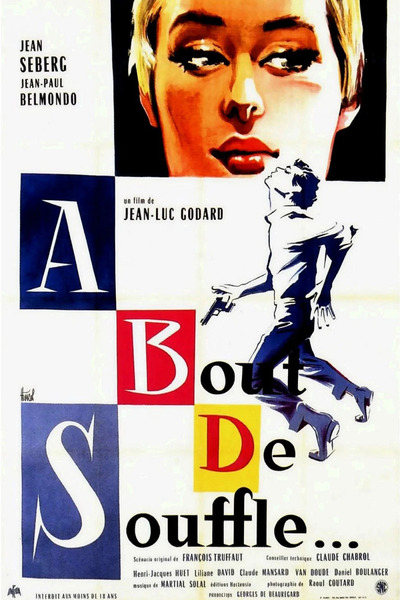
A movie from the French Nouvelle Vague about a gangster named Michel
and his love interest Patricia, a New Yorker working for a newspaper in
Paris. The story starts as self-narrated by Michel, yet doesn't continue
this way, showing it was mainly a crazy monologue. The plot is relatively
simple: Michel happens to have killed a policeman while escaping from
some messy situation in the south of France going towards Paris. His
plan is to meet a friend in Paris who owes him money, meanwhile he's
pursued by the police, and keeps pestering Patricia, which happens to
think she's pregnant with his child. Patricia ends up telling the police
where Michel is hiding and he dies from a gunshot.
There's a clear clash between the personalities of the two characters,
yet both seem to be lost in life. Michel is impulsive, he comes without
filters, and doesn't seem to care about the future, he acts whenever
he wants. Meanwhile, Patricia is tacit, but doesn't seem to either know
the meaning of her involvements in life, doesn't dare to move and stop
things to not get attached, letting things happen as they come.
This black and white movie is an amalgam of camera techniques and editing
innovation which gives it a very unique vibe. From constant jump cuts,
with seamless L and J cuts, dissolve transitions, crosscuts, iris cuts,
along with the memorising tracking and long shots at the flight/postal
office and the restaurant. A true exercise in movie making. All this with
perfect compositions, beautifully aligning foreground and background. The
piece is mixes with a score as a repeating leitmotif signaling a life
of crime.
Globally, this is a fascinating movie from a film perspective, but not
such a deep one from a story, theme, or character analysis in my opinion.
Come and See (Иди и смотри) 🔗
1985 • Byelorussia/URSS • Elem Klimov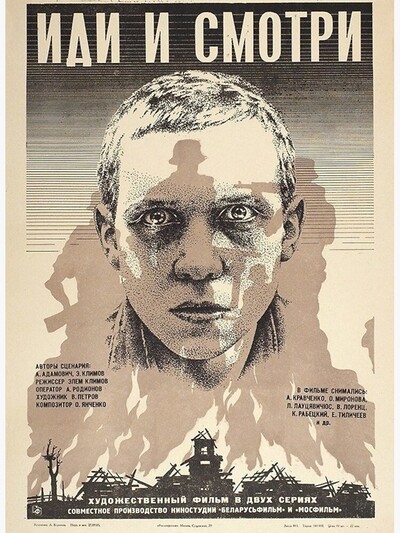
If horror and nightmares could be put in an expressionist and poetic
film it would be this one. This is based on the massacre of the 628
Byelorussian villages during WWII through the eyes of one of its
inhabitant, a young boy, Florian. The story often takes his point of view,
but never dives into what he thinks, it only does everything to submerge
us in the same environment he is in, be it through noises, pain, stress,
fear, focus, and other factors.
We are witness to the character development of this boy, from a gentle
and kind kid, cherished by his mother, and playing around with his
friend, to a part of something bigger and crushed by the atrocities of
the world. His innocence fades as he discovers the crude reality of war
and the monsters of humanity along with the symbols that push them to
perform the most disgusting acts. The players in this requiem of massacre
are few: the families of the farms and small villages, all similar to
another, the soviet communist partisan, and the so called Nazi militias
'liberators', which are instead envoy of death.
The movie plays in six main sequences, the conscription and camp
normality, the revelation after the explosion and meeting Glasha,
The disbelief at the horror of the genocide of his village along with
the survivors/refugees, the quest to find food for the refugees, the
second village massacre, and the soviet partisan ambushing the Nazi and
discussing revenge.
Across these, there are multiple continuous threads. In the very first
scene we're introduced to the instrument of war, of which the old
man warns them to not dig. We're reminded that this isn't a game for
kids. This sentences finds its ramification later, when Glasha says the
same thing again 'it's not your place'. Soon after they're bombed and
paratrompers attack. Normality starts to break down. The bird eggs he
stepped on, later seemed to have been from a heron, an omen of maturity
and knowledge, but also peace, which is broken. His innocence falls,
and he tries to run away from reality, from death, in the bog/mud,
but simply can't. When he meets the old man again, which is dying, he's
reminded 'didn't I warn you, don't dig'. Towards the end of the movie,
Florian seems to be as ancient and mature as the old man, he has seen
the consequences, he knows now.
There's another thread continuously present, which is about hysteria and
how the signification of things change. A peaceful meadow turns into a
deadly trap, fog is now welcomed, the moon is deathly, a church is a tomb,
laughter is fear, love becomes hate, goodness is sin, dedication is
insanity and desolation. The world seems upside down.
Yet another topic that's constantly there is the symbolism that Hitler
represents. People make a totem out of him, as a sort of surrogate to
piss Nazi. People spit on it. He's used as a justification to 'liberate'
the village and bring the carnage and genocide that ensues. The film is
also sprinkled with videos from WWII towards the end that play in reverse,
until it shows Hitler as a child. He's the icon and the source of all
this evil. Florian embodies this message by shooting at his picture at
the end. This is the only time of the movie where he uses the gun he
found in the beginning, striking at the source.
The atmosphere of the movie is rural, greenish farm village in the
woods. The ambiance often wet and heavy, sluggish almost, as if in
a trance. There are multiple scenes in the fog, where we're lost and
uncertain, or when we're in the trees, we're dizzy. These are all here
to make us feel the same way Florian is. The same is true of the audio
track, we're given the ears of Florian, buzzing and distorting the
music and sounds because of the explosion. Afterwards, the buzz goes
away but the focus is on the bombers in the sky, we're reminded of them,
of the ominous fear and bass that makes us uneasy. A few orchestra pieces
are here to amplify the immense monstrosity and despair. Apart from
these, the most notable aspect of the movie is the face closeup,
centered, pleading us, looking straight at us and telling the horror
they've encountered, judging.
Obviously, the major theme is the horror of war, and what transforms
men into unstoppable demons. How they can unapologetically justify
and dissociate from their radical actions through ideas that seem
incomprehensible to others. Furthermore, this movie tells a story that
is relevant in the mind of Belarus and Russia today, a perception of WWII
that isn't often talked about in 'Western Media'. It's about how they found
different Nazi factions and what it meant (SS Einsatzkommando, which were
Germans, Russian Liberation Army, which were a Russian defected unit,
and Schutzmannschaft Battalion 118, which were Ukrainian nationalists,
arguably still present today).
The title of the movie is a reference to the destruction of the Four
Horsemen of the Apocalypse, 'Come and see! ... His name that sat on him
was Death'. Now we definitely 'see', it's a motif of the movie. Be it
the closeup to the eyes, the photos taken, or the sparse shots of WWII
inserted at the end of the movie. We will remember the horror, we won't
forget, this is the message of this piece.
This is a heavy movie, not for the faint of heart.
Society of the Snow (La sociedad de la nieve) 🔗
2023 • Spain/USA • J. A. Bayona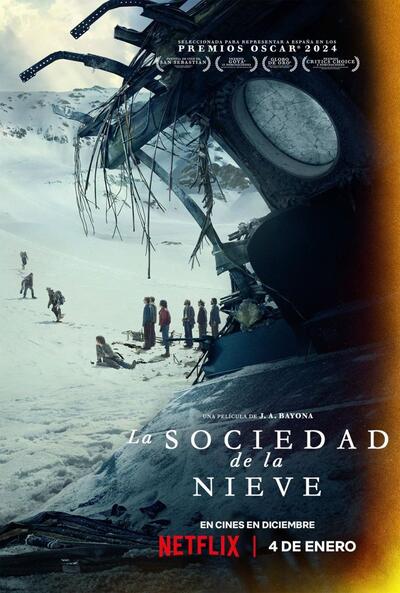
The gruesome tale of the 16 survivors of the 1972 Uruguayan crash in
the Andes mountains. It is narrated from the point of view of Numa
Turcatti. The story is simple: its a bunch of rugby teammates, all in
their early 20s, all with dreams and life ahead of them, some relative,
some friends, but all similar. They go on a trip to Chile on a small
50-something plane but end up in a crash due to air depression above
the glacier range. They first have to face the calamity of the crash,
death, and then have to survive in this desolate and empty environment
in which snow, the carcass of the plane and its luggage, and passengers
are the only available resource. Their humanity and faith are put to
their limits, and they resort to cannibalism to survive. After they
discover the tail of the plane which has waterproof material, they build
a sleeping bag and decide to send a few people to see if they can walk
to Chile to find help, which they eventually did. The movie ends on a
bittersweet note about life and its meaning, sacrifice and how media
cannot truly convey what happened on the plane, nor what the people
still feel to this day.
The characters have this deep camaraderie, it is shown through all their
actions. Yet they all come from different backgrounds, some were studying
to be lawyer, and couldn't bring themselves to do immoral things, while
others were doctors and more pragmatic, others were stronger physically,
others faithfully. This assemblage of people together and desperately
fighting for their lives in a selfless way.
There are few sequence that make up this piece. The similarities is that
they are like a roller coaster, from building up positivity about the
outcome, to being crushed by reality again, ups and downs.
In such depiction of survival, there isn't much to show apart from the
emptiness of the place, and the shots fabulously achieve this. The
aerial and far shot convey the immensity of the snow and the smallness
of humanity in it. Meanwhile, the only object the story rotates around is
the few pieces left of the plane, and the camera work makes this clear,
this isn't a perfect refuge, and can also be deadly. It is almost
claustrophobic compared to how the scenes are filmed outside. Yet,
the most impressive part of this film is the shots of emotions and
groups. This is done through different depth of field, switching from
person to person, or from dirty shots with the characters focused on
what they're doing.
When we are faced with the most dire situation we're bound to learn
something about humanity. As one of the scene conveys, they've lost faith
in the supernatural, but put their faith in their companions
abilities. This is the main theme, trusting others and respecting their
sacrifices to keep on living. Even when Roberto, the medical student,
carries with him the religious tokens of his friend, he doesn't do it
out of faith in a God, but as a reminder that he has the responsibility
of surviving, that it is his burden.
The Lighthouse 🔗
2019 • USA/Canada • Robert Eggers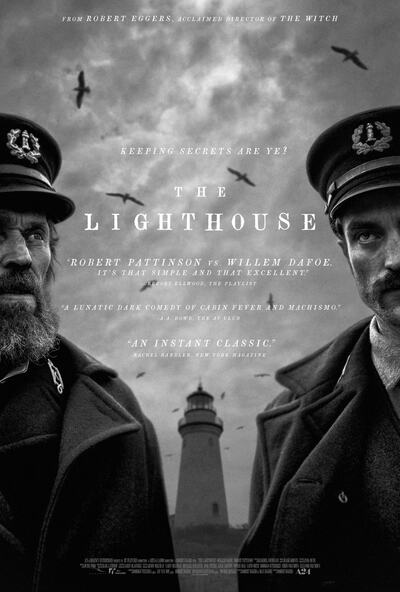
A surrealist psychedelic horror story. It is given by a clearly unreliable
narrator, slowly driven to insanity. The plot revolve around Ephraim
Winslow, formerly worked as a timberman, who now wants to join Thomas
Wake, formerly a sailor, to work as lighthouse keeper, a 'wikie'. Ephraim
slowly plunges into insanity through both superstition, hate for his
senior Thomas, overwork, guilt for his past sins, feeling judged and
inspected without privacy, and loneliness. The acrimony increases,
and both men drown in alcohol. Thomas never lets Ephraim work the
night turn and take care of the light, which pisses him off and makes
him imagine all the wonder and secret that could happen above. Ephraim
keeps hallucinating and eventually reveals that his real name is Thomas
Howard, and that the name Ephraim is actually the one of a former
coworker who drowned in front of him, whilst he didn't lift a finger
to save him because he despised him. He now took this new identity,
as a new man. Paranoia, guilt, and insanity takes upon Ephraim and he
ends up killing Thomas after he stops him from fleeing, or so it
seems. The movie ends with Ephraim/Thomas Howard looking at the light and
being blinded by it, falling down the stairs in a spiral, hypnotic motion.
The whole movie rotates around only two characters and their bitter
relationship. The sailor with his wild and fake stories, always drunk,
farting, giving long lines of poetry about the ocean, and mentioning
superstitions. Meanwhile, the timberman Ephraim is calm, lacking words,
but his anger builds up, his sexual repression and frustration is felt,
as if his whole life is imprisoned and insanity is the only escape,
jealousy to also be at the top of the lighthouse. He even imagines that
his frustration could be relieved there, since Thomas told him the light
is better than his wife. We can feel he sees his work as useless if he
doesn't do this particular task. They merge into one another when drunk,
the bottle being the catalyst.
A key element of the plot is the first outburst of Ephraim, when he
kills the gull that was in his way, soon after Thomas had warned him it
was bad luck to touch a sea bird. After that point, Thomas starts to take
seriously the mythological tales of the sea, and starts being attracted
to the mermaid statuette he found the first day. He starts to imagine
the Greek gods of the sea, the creatures, and the wrath of them. The
sea takes another aspect, both attractive and frightening.
The piece is shot in black and white, clearly hinting at the contrast
between light and dark, the tower guiding lost souls at the sea. There
are many other scenes emphasizing the size of the lighthouse, crane shots,
always going up, looking up, the two men are tiny compared to
it. Meanwhile, in the lighthouse buildings, the men are almost in a
claustrophobic space, all shots blocking them with objects. Furthermore,
in this small space two shots are omnipresent, putting both main
characters facing each others. Aside from this, the scenes where Ephraim
goes to the sea are always ravaging, as if the sea looks at him. To go
along with all this, we have a musical score that seems alive, it is
made of the sound of the wind, the deafly foghorn, and the splashes of
the waves, truly chilling.
There are so many themes and motifs part of this story. The theme of
the sea and its wrath, especially through the eye of Greek mythology is
omnipresent. It's anthropomorphized in all senses. Male sexuality is also
a major theme, with the lighthouse having a phallic motif, a comparison
of strength, domination and submission. This is seen through repression
of going up there and reaching climax which drives Ephraim mad and
jealous, finding relief in masturbation until he could not. Furthermore,
The lighthouse also seems like a place where one is imprisoned, lonely,
and has to wait endlessly to face their judgement. The light representing
a guide towards redemption, the good track, wanting to repent. Yet the
light is untouchable.
All and all, this is a tough piece, a true horror piece. It's a hard
to watch one, it got me trembling. Yet, it's definitely not the type of
movie that is for anyone, neither does it fit any clear category.
Tokyo Story (東京物語) 🔗
1953 • Japan • Yasujirō Ozu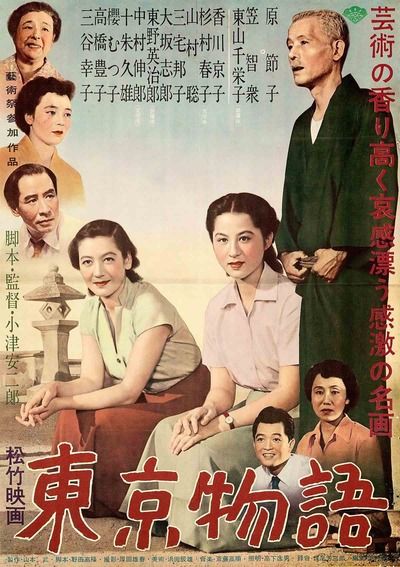
This film takes place in post-WWII Japan during the modernization and
reconstruction phase. It follows an elderly couple that visits their
children and grandchildren in the now-bustling and industrialized
Tokyo. The couple departs from a calm and peaceful village and makes their
way in train towards the city, visits the married children, the widowed
wife of one of their child that has died in the war, and the grandfather
also visits old-time friends to talk about changes in attitude of the
new generation. The couple is wholesome, and we witness a beautiful and,
probably, typical extended family, with its issues and troubles but also
with its connections.
The film is black and white, but that doesn't mean it doesn't bring
colors to our hearts, on the contrary. The subtle expressions are
touching, the emotions grabbing us with the closeup shots of faces. We get
two stark contrast in overhead shots, one above the sky of the undisturbed
(even by the war) fishing village, and the black industrial smoke of the
overcrowded Tokyo. Additionally, we also notice the opposition in the
apartments style, the ones in Tokyo being more 'compact'. To accompany
this, the musical score is unimposing, gently carrying us on the trip
with the family.
Unsurprisingly, one of the theme addressed is about the meaning of family
as the parents age, and the distance, differences, and expectations that
both have vis-a-vis each others. Furthermore, it's about time, the motif
of the watch and clocks is clear, we need to cherish the time we have
together, it's fleeting. Probably the concept of Mono no aware applies
perfectly here, the deeply felt realization of the ephemeral nature
of things, it's both a beauty to behold and something that can hurt. The
simple beauty of a life well-accomplished, feeling fortunate and
grateful. Additionally, the passage of time also goes along with change,
change in attitude, change in people, change in modernization,
change. This is probably why the grandparents have this conversation
with the widowed wife, to move on from the old, to live life fully,
to let past be past and embrace the future.
A movie that was deeply heartfelt, well recommended.
Stranger Than Paradise 🔗
1984 • USA/Germany • Jim Jarmusch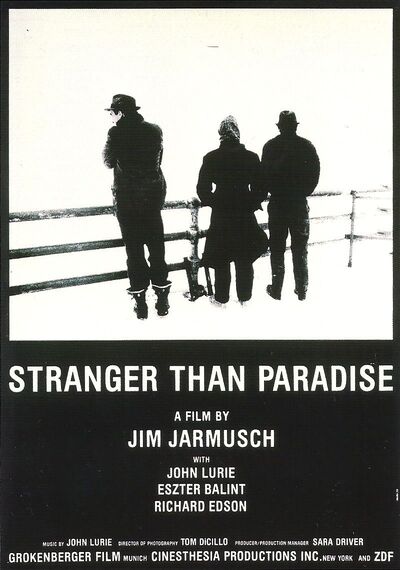
This piece of 1h30, which is described as an absurdist comedy, is neatly
split into three acts of 30min each. The introduction to 'the new world',
the passage of time after 'one year', and the 'paradise'. The story
revolves around Willie, a New Yorker of Hungarian origins, that is asked
to host his young 16 yo cousin Eva coming from Budapest, and Willie's
friend Eddie who often tags along in gambling and card games. We're
presented with the awkwardness of the situation, how Eva is criticizing
habits in the USA, how Willie is trying to fit in as an American and
never wants to know anything about Eva's life in Hungary, and how Eddie
relies too much on his good nature and perception of things without
actual practical experience. The story has no aim, no goal, nothing
to achieve, other than the characters meeting each others and trying to
go somewhere without actually reaching any sort of closure. We're
endlessly seeing how each of them is out of place. For example, Willie
never really introduces Eva to the American way of life, outside the
reclusion of indoor places as if cocooning her from the outside world
which is portrayed as desolate, noisy, or dirty places. The only thing
he offers is a dress to fit in, which she refuses, yet he's still a bit
protective of her. Meanwhile, Eddie likes Eva, but never makes it clear,
and is out of place and clumsy with the Hungarian people that start
to surround him. The group goes from New York to Ohio, and then from
Ohio to Florida, from city to snow to sun and beaches. Yet, nothing
is novel, no one is impressed, no one is satisfied. The two friends,
Willie and Eddie, hope their lives would be better by gambling, even
cheating, but apparently it seems it's all ups and downs. Eva is somehow
'lucky', someone confuses her with a drug dealer and gives her an envelope
with a huge sum of money, she thinks about leaving the USA but ends up
staying. Willie believes she's left and buys a plane ticket to catch
her but ends up stuck in the plane back to Hungary, the place he wanted
to be distanced from and which he had his identity crisis with. Eddie
is left in the car and dumbfounded about the situation.
The roles of each character is well-defined: Willie is the protective
and wannabe self-identified American, Eddie is the idealistic and
instinctual American, and Eva is the Hungarian cynical and uninterested
foreigner.
The artistic choice to be filmed in black and white emphasizes the
emptiness of the world, it makes us more aware of every tiny
details. Along with the transitions to pure black, blackouts, it forces
us to pause and reflect, absorb the scenes. Yet, there are no real
sequences, since all shots are separated by these blackouts transitions,
we watch the movie as a series of snapshots. The types of shots taken
are mostly blocking, it's the actors moving and not the camera, only a
few rare shots are trucking shots. This gives an atemporal feeling,
adding more to the concept that the characters are out of
place. Furthermore, as soon as they arrive to another destination in the
car, we're presented with wide far shots displaying the full
environment. The musical score that accompanies all this is a psychedelic
classical orchestra mix. Along with this we have the diegetic 'I put a
spell on you' from the music player that Eva carries.
A few memorable episodes set the tone of the movie. The one when Willie
eats TV dinners and Eva asks about the origin of the food. Or when Willie
tries to say a joke but forgets it. Or yet another where Eddie and Willie
simply sit saying nothing and only sipping beers. However, the ones that
are more striking are the ones repeating how nothing changes. From the
train station scene where Eddie, the usual idealist realizes his vision of
Cleveland was false: 'It's funny you come to some place new and everything
looks just the same', and Willie ain't surprised 'No kidding'. Or the one
where the three go to visit the lake, but it's frozen and all white so
there's nothing to actually see. Then Eddie says 'the snow is beautiful'.
The motif of emptiness is probably the most omnipresent in this
piece. They're constantly trying to see what they should do, where to go,
kind of lost. Nothing truly happens, 'We're not doing anything', 'What
do you want to do', 'Everything looks the same', 'This looks familiar',
'If i don't tell you what to do you do nothing at all'. The most ironic
totem of this is the peanut container, which Eddie still packed even
though it's empty, carrying his baggage of emptiness to Florida, but
when they leave Willie asks again if he wants it but he replies 'why
would I want the peanuts, there's nothing in it'.
Another way to perceive this is the countless references to blending in,
and to be bland. We hear a lot of indirect talk about travel and origin
without it ever being mentioned directly, of it being rejected. 'You come
here and you should dress like people from here'. But things don't look
like real things, 'it doesn't even look like meat, has no origin'. 'Is
Cleveland like Budapest', seems like a deja vu when they get there.
What's probably more implicit is the recurrent criticism of the American
dream. We see a couple of strangers in an idea of paradise which is
never reached. With the recurrent idea of gambling your way, trying to
'make it big' and taking all opportunities regardless of morals. Eva
comes from Hungary, the other side of the world, but ends up living in
a desolate and sad city and working at a hot dog stand. We also see how
Eddie is optimistic about any region in the USA without even having been
there, but when they are finally there it's not as exciting. His only bad
feeling about a place is when it's outside the USA 'what are you going
to do in Budapest'. Similarly, the leitmotif of cards and gambling goes
along with the concept of 'playing your luck in the USA', of wishing
you'll be great by sheer luck. Eva does get lucky, but by a weird Deus
Ex Machina, a literal joke about what it means to 'make it'.
The truth is that these characters are trying to escape the harsh reality
of the USA: that it requires actual hard work or cheating. Willie harasses
the factory workman when asking for direction and can't imagine working
in a factory. He falls asleep when they pass in front of the factory. They
dream of the American dream, while wearing glasses and looking at desolate
places. It's pure escapism, and the leitmotif of the song 'I put a spell
on you' says it clearly.
It's not a film for everyone, but I definitely enjoyed reflecting on it.
The Prestige 🔗
2006 • USA • Christopher Nolan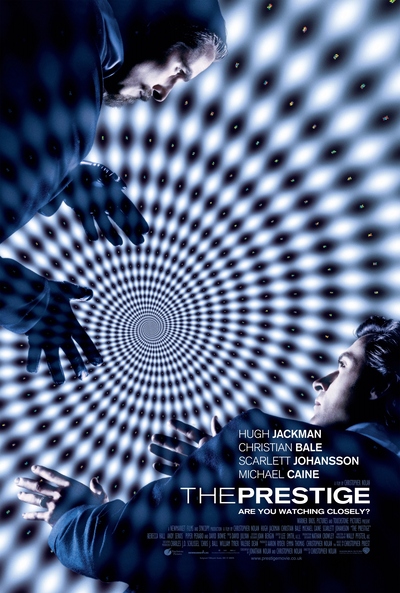
The prestige starts by telling us that every magic trick is split into
three parts: a pledge, a turn/twist, and finally the prestige. The
prestige is the ultimate part of the act, a reversal of roles and a
rediscovery of what has been lost. Yet, in the introduction, it is also
said that the trick to perform the twist and prestige should be left
untouched, to be left to the imagination and not dig and researched,
we don't want to know. This play on both words and actions is the core
of this story, from the stage engineer building the magic machines which
is the introductory and end narrator, to Robert 'The great Danton' (Hugh
Jackman) that subsequently takes the role of narrator, interwoven with
the narration from Alfred 'The professor' (Christian Bale). All their
voices mixed together in a confusing style where the framing device is
never set in stone, we keep asking 'who's story is this', 'who's central',
without an answer, but instead with constant role reversals. The story
takes us on a tale of betrayal, jealousy, and obsession as the wife of
Robert dies during a performance. Robert is sure that it was the fault
of Alfred, but we can never know. Each magician keeps track of their
lives and trickeries in diaries, which somehow each end up in the hands
of the other. Their obsession indirectly morphs their lives together,
each of their magic trick an intended message to the other, even living
their lives as if it was a trick. The intrigue builds up, the spats and
attacks continue, they try to destroy each others. Lastly, a final twist
happens, a sort of botched Chekhov's Gun which appears mostly like a Deus
Ex Machina from the movie director to end the movie in a full circle.
Adding to the idea of the narrator constantly changing, the movie is
also filmed in an anachronic fashion (the intro is also the outro for
closure). We get a few pieces at a time, and like a thriller slowly
build ideas and judgements about each characters, which obviously are
also part of the trickery: the director is also tricking us. This could
also be interpreted as a display to how the two magicians' lives are
now interlinked.
Similarly, these judgements about the characters, about their inner
thoughts is constantly proven false. We're duped and can't put them
in boxes.
The movie's score is fantastic, grandiose, taking us on an gloomy and
thrilling vengeance. This is accompanied by an atmosphere that is dark,
constantly at night in candle light and wood, and when it's the day,
in the light, it is an uneasy blue tone of icy Colorado and metallic
machines, or the extreme white of the morgue and of wanting the truth
and cleanliness, or the dizzying orange of the day about jealousy in
all its forms. The types of shot taken are mostly shoulder shots and
reverse shots in discussions, and they have shallow focus, isolating the
subjects emotions and expressions.
The themes touched are obvious: deception, obsession, jealousy, rivalry,
and trickery. We can quote: 'you do deserve each others', 'You lie even to
yourself'. There's not much deeper meaning in the movie than the cost of
obsession, rivals are closer and more similar than they think. The only
hint at something deeper might be the fight between Edisson and Tesla,
with a mention that the extraordinary is not allowed in science and
industry. But this was such an aside that it's not worth going into.
I have a lot of criticisms about this movie, especially the Deux Ex
Machina that was pulled at this end. I feel it wasn't performed
properly. Furthermore, each characters have this hint of James Bond
competency porn, which is unappealing, along with the 'extraordinary'
elements that felt out out of place towards the end of the
movie. Additionally, since I've watched The Illusionist which was released
the exact same year, the movie felt like a cheap copy of another magician
story where everything is permitted, a sort of House of Games. Could
it have been a message because of the spat between the directors of The
Illusionist and The Prestige. Yet, I felt like The Illusionist was better
(but I haven't written about it on this blog). Incidentally, but probably
purposefully, the anachronic nature of the narrative harks too much at
the movie Memento (2000) from the same directory (Nolan) where the exact
same concept of identity merging happens (An excellent movie by the
way, but also not written about on this blog). For all these reasons,
this felt like a generic movie, yet another movie that is like some
other you've watched before, swapping elements here and there. Overall,
not recommended.
Chungking Express (重庆森林) 🔗
1994 • Hong Kong • Wong Kar-wai
This is a story in two parts that follow two policemen, they are
juxtaposed one after the other. The connection between the stories is
done through the introduction of a new character Faye, and the common
criterion of the Midnight Express snack. Faye is the new staff member at
the Midnight Express. Both of these stories are about different policemen going
through their breakup and somehow finding themselves at a snack.
The first follows He Qiwu, a policeman that broke up on April's fool day,
but has yet to believe his ex went away. Hence, he waits for her everyday
at the Midnight Express, and on his way back buys a can of pineapple that
expire on the first of May. The first of May is coincidentally also his
birthday and the name of his ex, indeed a much significant day. Meanwhile, in a cross-cutting,
the story also follows in parallel a woman drug dealer that hires Indian migrant to
smuggle cocaine to another country. Someone these two characters find
themselves together on the eve of the first of May in a bar, talk a bit,
and end up together, one completely wasted from the running up failed
drug deal, and the other from the blast of the breakup. On the next day
the woman calls him to wish him happy birthday.
The second story is about another policeman going through a breakup,
this time with a flight attendant, as he says 'she flew away and his
ticket got canceled'. The new staff of the Midnight, Faye, falls in
love with him. She's an avid fan of music from California and dreams of
traveling there. By happenstance, the ex has sent a letter to the Midnight
Express with the keys of the apartment in it. Everyone opens it, but Faye
ends up keeping the keys and entering the apartment of the policeman
without his knowledge. She changes bit by bit things in his apartment
trying to cheer him up. Indirectly, the policeman had a connection to
this apartment, literally talking to items in it. He ends up finding
out about her tricks and wants to love her, but she feels inadequate
and not ready. She doesn't meet him at the bar, but end up sending him
a boarding pass. Later, Faye then morphs into a flight attendant and
returns to Hong Kong, she finds that he has bought the snack bar and is
converting it into a restaurant. He presents her with the boarding pass,
which was washed up, asking her where she wanted to take him, she asks
him where he wants to go, she replies 'Wherever you will take me'.
These stories are filled with tiny details and sub-plots. While the
first is played in the head of He Qiwu, the second plays in the head of
Faye. Yet, everything is interwoven together in a tightly knit piece,
every character helps us understand the other.
The film is brimming with countless dutch angles, the use of fast
moving lights, sometimes where the character is moving slower than
their environment. There's so much use of unclean shots and composition,
showing how things are messy but related. Add to this, the recurrent
audio as motif, each unique to the separate stories.
These elements add to the theme of relationship and connection through
the passage of time. As the first story shows, we come across strangers
in our lives but never know who them are. The cans with expiration dates
are highly symbolic of time, 'everything has an expiration', same with
us when he refers to his 'birthday'. And the only person who contacts
him is the person that is his total opposite. He runs to sweat away his
tears, runs and creates distance.
The first story has more of an emphasis on the past and expiration,
while the second one pushes on the topic of change. This is done by the
swapping of house items that are so common and intimate, but then unknown
and new. Putting our house in order, quite literally, and thinking his
house cries. Along with the musical theme and the travel theme, this
goes along quite well.
The amount of unclean shot through glasses is significant. Glasses,
in general, be it seeing through glasses (the shots), or glasses that
people wear, is also a leitmotif. We see through them and they change
our vision. We don't see people for who they are, things are fuzzy unless
we take the time to know them.
Overall, a beautifully made piece of art permeated with tiny details we
only notice after watching it.
Rashomon (羅生門) 🔗
1950 • Japan • Akira Kurosawa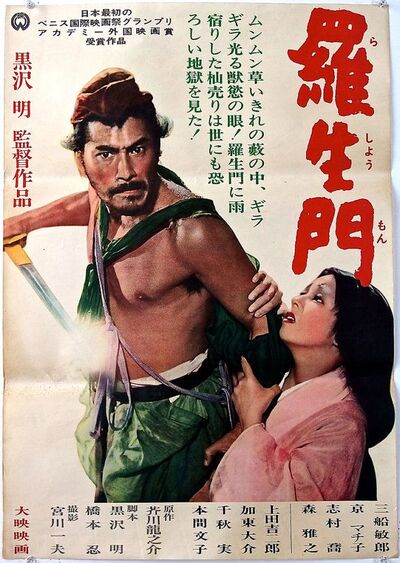
A movie classic that has given name to a judicial psychological effect:
the rashomon effect. The story takes place at the end of the classical
Japanese history, also known as the rise of the samurai class era. It
is about a commoner who joins a priest and a woodcutter taking shelter
under the dilapidated rashomon gate, the south city gate of kyoto. The
woodcutter then tells the commoner about a judicial case he was part of,
along with the priest, and that shocked them both. As he recounts it,
we see that everyone gave mutually contradictory testimonies, and that
subjectivity and truth are uncertain. The priest laments this and decries
humanity, saying everyone lies for their own good, even to themselves to
protect their egos, truth is gone. Yet, as the movie ends, and
simultaneously the rain stops, he regains a bit of faith as the woodcutter
adopts a baby that was left at the gate.
The narrative uses the framing device of the storyteller, we're taking
the position of the outside, the same as the commoner who just arrived
to hear what happened. It creates this form of external judgement,
we're here to debate and try to make sense of what happens. Indeed,
the commoner is our companion in this quest, and the commentary he
gives are explicitly saying what we've been thinking. When he mutters
'the more I hear the more confused I get' we can only agree.
Since this is samurai-era japan, the costumes are on point. Yet, most
other characters, are wearing clothes that are falling apart, showing
the discrepancy between the rich samurai and the others. There are only
a few characters on which the story rotates. However, since we see them
acting in the different testimonials and interpretations, their way
of being is widely different. When switching perspective, they change
personality. The simplicity of only having a few characters makes us
focus on the replay and the minute differences, emphasising the human
aspect and facial expressions.
This is all accompanied by a few well-placed scores, with the theme
soundtrack being reproduced at both the start and end of the movie,
giving us a sense of closure. The simplicity is also found in the camera
work. The whole piece is in black and white yet we don't feel that colors
would have been an addition. Furthermore, the shots are taken in ways
that pushes forward the topic of subjectivity. For instance, when facing
the judge, the camera never turns back on the judge, which gives us the
impression that we are the judge. Similarly, when the stories are given,
we feel like a witness, either taking the position of a certain character,
with long and emphasized over-the-shoulder shots, or shots that follow
strictly the one who's story is being told, be it if they're on the
ground or anywhere else, regardless of other characters. The director
has mastered the art of foreground and background contrast, giving
continuation between both. Along with this the use of horizontal lines
is omnipresent, delimiting the frame, be it from walls or stairs or
others. Along with good use of light as symbols and a dynamic camera
twist to follow movement, the director must be applauded. Finally, most
transitions are cut transitions until the final fade transition into a
sunny day, portraying that time has passed and things must go one.
The main theme is obviously subjectivity and contradictory account
of truth, but also what it means to be impartial, accurate, and give
justice. It then touches the subject of humanity as a whole and communal
living. The question of selfishness, being dishonest and making excuses
often comes up, how humans unconsciously lie to themselves and only
believe in the 'good stuff' because it's easier to assimilate that
way. Ego protection. Definitely, the movie starts with rain, washing
away sins, as the priests puts it, and ends with the sun coming back
and a new born with hope, giving back faith in humanity. The use of the
title and the filming spot: rashomon city gate can also be interpreted
as additional meaning. It is said that a demon was living there but was
driven away because humans are more horrible that it was. Add to this
that the city gate means 'main city gate', the opening of civilisation
in a sense. Furthermore, rashomon was known to be an undesirable place
of the city, where people left abandoned unwanted babies, corpses, and
it was a hideout for criminals. In sum, it's the place humanity doesn't
want to look at, the ugly truth of human nature, and we have to face it
to move on.
The Wicker Man 🔗
1973 • UK • Robin Hardy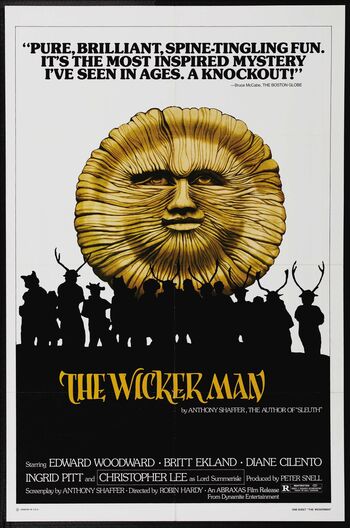
A horror/thriller/mystery story about a deeply-religious christian policeman,
Howie, following the reported disappearance of a girl, Rowan, on a
privately-owned island, Summerisle, that is inhabited by villagers. He
quickly discovers that these villagers follow their own traditions and
rites, considered by him, and us, the implicit viewer, as decadent,
and out-of-the-ordinary. For instance, they embrace their body, walk
naked, aren't ashamed of the cycle of life, and believe in ancient
Celtic folkloric gods and traditions such as the celebration of the May
day. None of the town's folks are compliant with his requests and he
gets frustrated after possibly having discovered the tomb of the girl. He
meets with the leader of the island, a gentleman named Lord Summerisle,
and discovers that they've left Christianity and embraced a religion
that is closer to nature, something that made everyone more liberated
and happy about life. Howie continues his investigation without luck,
but with more frustration, on the day before May day, he plans to get
help from the main land but his aeroplane won't start, he is then stuck on
the island. As he goes back he is led by the citizens into the celebrity
and inadvertently takes on the role of the fool. It is then discovered
that the missing girl was not in-fact missing, but was used as a bait to
lure Howie to the island for him to become the sacrifice needed to stop
the failing of the crop. The requirements were that the sacrifice should
come of their own free will, have the 'power of a king' (policeman), be
a virgin, and be the 'fool'. Howie is taken into a giant wicker man and
set on fire along with other animal sacrifices. The folks sing 'Sumer
is icumen in', while he recites Psalm 23, prays and curses them.
The way the story is told is captivating, we're taken aback by the
constant clashes of culture, beliefs, and religions. It is seen from
the perspective of Howie, the policeman, supposed to represent order
and what is right, a faithful christian man. Yet, he is displayed as
out-of-place and uneasy. Meanwhile, the villagers are overly joyous,
seen a life-loving folks, without a worry. We're left wondering about
the murder and how it could've happened in such a place, nobody seems to
answer this. It's a unique kind of thriller in the way it is framed.
The piece doesn't have many musical scores, instead, it is the town's
folks that are singing and playing music (diegetic music), introducing scenes. This
indirectly seems like a funny musical, yet we're watching a thriller. Such
scenes adds to the uneasiness, we sympathize and identify with Howie and are also
lost and clueless about what is truly happening. A few perfect scenes that show this
are the introduction of the first town people's, which is a very long
shot passing from one face to the next, then switching to a reverse shot
in which Howie is looking down on them, portraying authority. He is
almost always filmed in this way, from when he's being shown the beetle
going round-and-round (symbolizing him going into their trap), to when he
looses the 'battle' and is sacrificed, he looks down on the villagers
up-above, in the wicker man, cursing them. There's never a realization
that he might be wrong and 'pranked'. There are many transitions using fade-ins,
as if time passes, yet the policeman is still constantly lost.
The film is full of tiny symbols and societal criticisms. Definitely,
there is the critic of cultures and religions, and why one would be
better than another, what is ok and not ok, and what happens when
it clashes. That coincides with the trope of 'you were the fool all
along'. Apart from this, we have old folklore symbols, mostly related
to nature and coming back to roots, such as the sun and sea god, but
mostly the sun, the Green Man Inn (a foliage head), dancing across fire,
planting trees on graves, the hare of tricks, and many more. The initial
scenes definitely shows this, as Howie is in the plane, we see great
nature sceneries, and then as he steps on the island there is a focus
on plants and others, this is then a main theme all over the rest of
the movie: seeds, plants, life, growth, death, and rebirth.
Nostalghia (Ностальгия) 🔗
1983 • URSS/Italy • Andrei Tarkovsky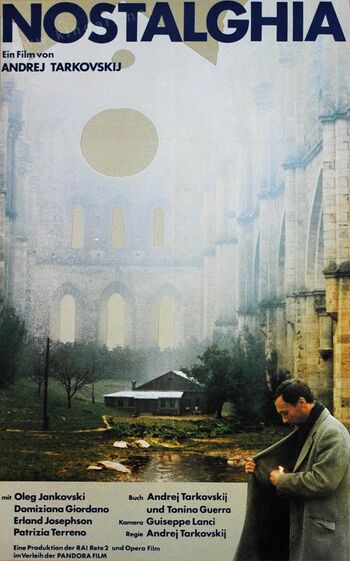
This is the story of a Russian writer, Gorchakov, that is traveling to
Italy to trace the steps taken by the person he wants to write about: A
Russian composer who studied in Italy, came back to Russia, and then
became alcoholic and committed suicide. He's not so fluent in Italian and
is thus accompanied by a woman translator/interpreter, Eugenia, who
gets infatuated with him, yet he's not interested in her advance
and is greatly confused by it. As he travels, he gets deeply homesick
and is entranced by things other than his work: mainly a mad man who had
imprisoned his family in his house for 7 years thinking the world will
come to an end. Eugenia, the translator, leaves after he refuses her
advances, saying she can find a boyfriend in Rome. Meanwhile the Gorchakov
spends his time dwindling and longing for home, the madman, and what it
all means to be part of this world and yet so distant. As he was about
to fly back to Moscow, he receives a call from the interpreter saying
the madman, Domenico, was staging a protest in Rome. After hearing
that, the writer drives back to the bath where he initially met him, and
fulfills a promise he had given: to carry Domenico's flame from one side
of the pool to the other, since every time the madman attempted it he was
pushed away. At the demonstration, Domenico preaches about civilization,
especially its ugliness and shortcomings, how we are so divided now,
and then commits suicide by immolation. At the same time, the writer
walks the pool with the candle and, as he finally touches the other side
of it, dies of a heart attack.
The narrative style is implicit, nothing is clearly said and everything
is implied as we follow Gorchakov and his constant daydreaming. The
dialog is also sparse but powerful, every line is meticulously said,
almost in a theatrical and unnatural manner.
There are three main characters to the story. Gorchakov, the writer,
which is sorrowed, homesick, and to which we are the audience of his
dreams. Eugenia, the interpreter, which we only see from the perspective
of Gorchakov and who appears disorderly and chaotic, almost insane and
unpredictable. And Domenico, also presented from Gorchakov perspective,
which seem legendary, deep, full of hidden wisdom yet misunderstood. The
way in which they play these roles is timid, they're almost not present
and yet are, the environment shapes them, as if they were puppets in
a show.
This is all taking places through scenes of constant fog, which adds to
the dream-like aspect of the movie. It creates this uncomfortable and
heartrending feelings, everything is submerged in water all the time,
and the characters are swimming, walking, drenched, or taking cover in
ravaged buildings and ruins. The world and elements are taking back the
architecture from humans, and this is clearly shown in the
beautiful landscape shots, and the focus on these aspects of the
buildings. Tarkovsky's signature extreme long shots take us aback, we
get lost in the poetics of the movements. It's the characters moving in
the scenes, not the scene moving for them, it makes them appear smaller
compared to their environment, as if claustrophobic. The musical scores
are spares, barely three orchestra pieces, and placed at specific moments
of amplification.
There are a few repeated themes and elements that are spread across the
movie. On one side we have the faith, the bath (Bagno Vignoni, which we see
from the perspective of Saint Catherine as a holy place to wash sins), and
the candle or light (to bring knowledge to the world), are interlinked. On
the other side, we have the theme of homesickness, with the barriers and
clash of language, art and culture, along with the 'out-of-place' and idea
of being lost, plus the concept of motherland/fatherland and 'home'.
Some episodes stand out and are memorable, most of there are contradictory
and ironic. The faith scene at the beginning (talking about birth and
conception) has a sexist comment asking why it's only women having so
much faith, this is contradicted with the scene of the madman that is
shown to be a faithful man yet no one was able to see it other than
Gorchakov, this contrasts motherhood and fatherhood or motherland and
fatherland. There's that scene in the hotel where Gorchakov and
Eugenia are sitting facing opposite directions and saying they'll
never be able to understand each others, that things do not transpired
interpretation. Yet Eugenia is an interpreter and is deeply hurt by this,
and as the movie continues, it seems she's not able to also interpret the
feelings of homesickness of Gorchakov, only the madman can, as madness
and homesickness are seen as one. Another striking scene is the one
in which Gorchakov says the following, I paraphrase, 'Being away from
the sun for too long to then be afraid of the light', to then follow
by thoughts of the candle, the burning man, faith and returning back
home. There is also a scene where he talks to a young girl, asks her if
she's happy about her life, and then tells a story of a joke of a man
saved from a sinking pound, but this dirty pound was his home.
This piece has so many interpretations, from the characters always
walking through ruins of the past, mentioning how he longs but don't
want to return, living in between, lost, out of place. Nostalgia and
madness are intertwined, both misunderstood. Motherhood and fatherhood
are displayed as both land and home vs being protected from the world and
from leaving/traveling to see it (and its end). This is what can be
interpreted when Gorchakov says he understand Domenico. It can seem that
everyone can look insane when not from your culture, misinterpreted. The
writer passes through an identity crisis, but when they want to share
the light it kills them, they aren't who they used to be. By breaking
walls between people and culture we destroy ourselves, we become a
sacrificial light.
The Animal Kingdom (Le Règne animal) 🔗
2023 • France/Belgium • Thomas Cailley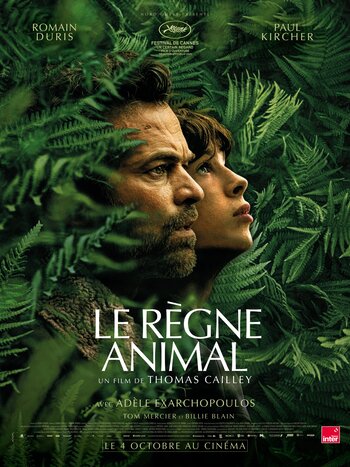
This is a sci-fi drama about a world in which a novel disease is
omnipresent in the background of everyday life, this particular mutation
turns people into creatures that resemble animals. People try to contain
it, while continuing their everyday life normally, even though they are
clueless about the reasons and mechanism of the mutations. To achieve
this they hide away these people and shun them from society. The story
follows a family of three, mostly the father and son as the mother
turned into a 'creature' and they deal with the situation. Soon after,
the son discovers he is also affected by the mutation, and an ordeal goes
on where father and son have to overcome both personal difficulties and
societal pressures.
The character development is subtle, pursuing the thread of two
main characters: the father and the son. The father now being the
only parent available, trying to take the full caretaker role, yet
calm and showing his love and warmth while having to juggle so many
difficulties. Meanwhile, the teenage son has to face his own personal
changes, especially physical as he turns into a 'creature'. His part of
the story is more of a coming of age, learning to embody life as who he
really is and find freedom. For the father, the movie is strictly divided
in two section. Initially he attempts to sway his way and adapt to the
society, as he sees it as the best life for his family. As things go
more sour, he's open to try something new, to go against the 'norms',
especially as he hears the rumors and bigotry against the creature,
he feels them deeply. He adjusts and pushes his son to be himself,
fully accepting him with love. The actors achieve their role superbly.
The costumes and camera works are exceptional. While the special effects
are limited to making the creatures, it is still done in a way that
transcends the movie, we're taken aback by the realistic
aspect. Meanwhile, the camera action has a lot of upper body (shoulder
level) shots and facial expressions, especially in scenes involving
father and son. Apart from this, we have more theatrical scenes with a
fixed camera, some of them are from the mundane city life, and others
are taken with a bird eye view or grandiose far away spectacle view
in the forest. The forest shots are the emphasis, they are surreal,
especially a single shot where the camera twists and flies through the
tree, mimicking a bird and referring freedom and the new creature friend
of the son. More active scenes have moving cameras work which are wobbly
and dizzying as they push us through the action.
The music and sound effects are faint and act more as sound effects. The
director is not afraid of silence and raw dialog, or to just leave the
sound of nature as is.
The colors are left as natural, real and immersive. We live in the forest
with the contrast of day and night as they come. The days are for play,
school, learning, and the night is for searching, remembering, and
fighting societal norms.
Many motifs and themes are present in this film. The coming of age one
with the son, especially regarding being accepted for who he is, making
peace with his family life. Nature is also omnipresent, it's almost left
unsaid that human are turned into other animals as a sort of revenge
against what they are doing to it. The witch hunt theme is also present,
especially in the end scenes at the St.Jean holiday. This holiday in this
region of France, Nouvelle-Aquitaine, is a youth rite of passage holiday,
showing that they're now part of society and more mature. However,
here instead the 'berger', the shepherds, the one wearing the stilts,
and trying to put in line the 'sheep' that strayed from the group.
There's a lot left to be said about this movie, but overall it was a pleasant
watch, highly recommended.
Quest for fire (La guerre du feu) 🔗
1981 • Canada/France • Jean-Jacques Annaud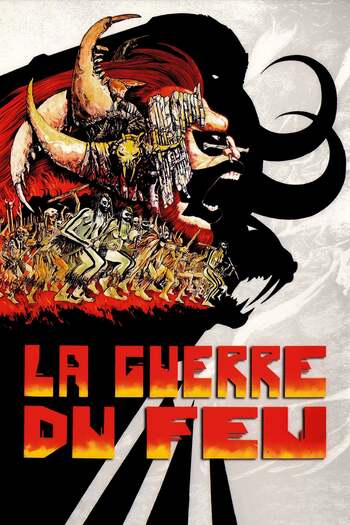
Quest for fire presents us with an early human era, a narrative of
tribesmen. In these dire and dangerous times, fire meant everything,
it is cherished by them, the source of warmth, communality, life, and
rejoice. However, as soon as we understand this, another more 'hairy'
tribe, attacks this initial tribe to steal the precious fire from
them. The 'keeper of fire' seems to have survived and saved the last
flame in a transportable receptacle, however, he slips in the swamp and
the flame almost dies. A man from the tribe tries to resuscitate it but
it dies. A scuffle ensues, and the oldest man in the tribe makes peace
by picking a group of three men to go on a quest to find fire again.
This quest takes them to faraway lands where they meet cannibals, the
leader of the group saves a woman that was about to be eaten, they fall
in love. They're also able to steal fire from the cannibals. On their
way back, the woman points back to the direction of her tribesmen and
refuses to follow the three men and flee. The leader, who fell in love
with her, realises this and decides to go find her. He is then welcomed
by a more advanced tribe, who uses body paint, builds huts, and vessels,
and has garnered the ability to summon fire rubbing sticks together. The
two other men, also join in and are taken in this more abundant tribe,
but then decide to leave by force.
A key event happens on their way back when they're attacked by another
'hairy' tribe, and are saved by mammoths. The leader summons his wits
and approach the giant mammoth, thanking them for their protection. The
'hairy' tribes flee. Finally the men come back, the flame they have been
carrying dissipates once again in the swamp, but this time the leader
carries the knowledge on how to summon it from sticks. It doesn't work
and we can clearly see from camera movements and faces that he's feeling
discomfort and uneasy. His new companion takes over and starts the fire,
the tribe is elated.
While this story is counted without words, but only through a rudimentary
language, we can still deeply connect with the characters, find their
uniqueness and humanity. Different tribes have different features,
we can see all facets of humanity, raw, unhinged, along with things we
might find awkward. There's no shyness about what happens, can we
judge them?
Humanity is portrayed as non-exceptional, almost on the same level as
other animals, that is until they meet the more 'technologically'
advanced tribe. The animism is clear, at least from the main tribe we're
following, especially in the scene where they connect with the mammoths,
there's a deep religiousness to it.
The same can be said about the fire, the central theme, which mesmerizes
everyone in that world, since it is so hard to keep and since its
knowledge is unknown. As they say anything that can't be explain is magic.
This is all filmed in an almost 'national geographic' way, following
characters as they scavenge and explore this dangerous world that
can kill them at any moment. The costumes, and scenes are on point,
immersing us in this atmosphere. This is all balanced with a few aerial
shot and shot that look at the sky, displaying a connection, sometimes
deep meditation about life. Birds flying in flock, with the promise of
better lands and better times.
Network 🔗
1976 • USA • Sidney Lumet/Paddy Chayefsky
This is a masterfully performed satirical drama about modern consumer
society, corporatocracy, and the propaganda and life through the lens of
television and more widely mass media. It's presented as the backstage
of the television crew, showing the inner workings of the television
business, from ratings, to personality, scripting, audience attraction,
bureaucracy and takeovers, etc.. We're the exceptional viewer of what
we're not supposed to see, how they manufacture content for the masses,
yet the manufacturing itself now becomes content too. The story follows
a news anchor for UBS evening news, Howard Beale, whose rating drops
and has a life crisis and then mental breakdown. The president of the
branch informs him that he'll be replaced and won't get more time on air,
hence Howard goes on a frenzy and declares he wants to commit suicide
live on television. This initially goes unnoticed by the live editing
crew, passively doing their job, but then an uproar and commotion
starts as the upper management realizes this declaration has raised
their viewership rating. Howard's boss doesn't want to get involve and
said the man needs mental help. Yet, the young programming chief, Diana,
wants to use this opportunity to turn Howard into a show, displaying
the anger of people at the current depression and societal crises and
life being bullshit. Diana and Schumacher, Howard's boss, get into
an affair, while Howard continues his descent into angry madness on live
television, turned into a clown show for the populace that needs a
demagogue and emotional outburst. The slogan of the show then becomes
'I'm as mad as hell, and I'm not going to take this anymore!'. This
happens until Howard's discovers the parent company of UBS, CCA, will
get bought by a foreign Saudi corporation. He spouts about it on air
and encourage people to send letters to the Whitehouse to not allow
it. He's called by the big boss, which sells him the idea that the world
now doesn't work with nation, but that it's corporations that are the
building blocks of reality and that people are not citizens but cogs in
the machine of these big companies. He is then killed on stage afterward,
the movie ends on a frame of his face.
The whole piece is mostly filmed indoor, in closed spaces, with artificial
office light, people always wearing suits and attires, showing that
everything is about work, everything is a machine. There's no music apart
from the one that is included as part of shows within the film. It's
almost cold, and heartless, but the irony of every frame and every tirade
makes us speechless. It's reality that is laughable and we know it.
There are many noticeable characters, Howard being the main voice of
critique of mass media, regurgitating what we've all wanted to say for
a long time, what we've always felt. Yet, he's himself turned into a
mass media piece. The rejection and fight has only strengthened the
opponent. Similarly, the young revolutionary youth that are hired by
Diana are also turned into another show for an audience, a package
with a script. Another line in the script follows the affair between
Schumacher and Diana, which includes a generational clash. Diana is from
a new generation that 'grew up on Looney Tunes', distances from reality
and seeing everything as a trope, a cliché, a scenario. This percolates
in her personal life, and pollutes the life of Schumacher.
The symbolism is clear, we're reminded of McLuhan's 'the medium is
the message', over and over again, or of Baudrillard's 'simulacra and
simulation'. The rants that Howard's say seem directly taken from their
books however, even though they resonate with the crowds, the preaching
doesn't have an effect since it's passing through the same medium. We're
left with an hopeless and saddening feeling as we're also consumers of
his sermon.
Ironically, and to play in the devil's hands, I'd recommend watching
it, and afterward having a go at reading authors such as Jean Baudrillard,
Pierre Bourdien, Byung Chul Han, McLuhan, Roland Barthes, Umberto Eco,
and so many others.
Eyes without a face (les yeux sans visage) 🔗
1960 • France/Italy • Georges Franju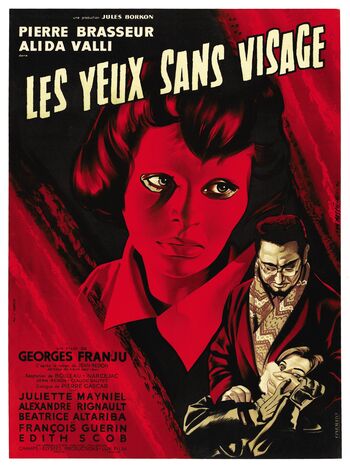
A French horror tale of a mad scientist, Dr.Génessier who abuses his
power and contorts his moral views to try to fix the life of his loved
ones, to heal their faces and bodies disfigured during a car accident
he caused through reckless driving. The story is structured in such a way
that it slowly unfolds, like a thriller. We uncover the truth about the
plot piece by piece, nothing is taken for granted. Beautiful women have
their face harvested by someone who at first seems to be the secretary
of the doctor, but then turns out to be his wife who was also present
during the accident and had a successful face transplant. The daughter,
Christiane, still has her face 'missing', and wears an emotionless mask
to hide it. She broke all mirrors and reflecting surfaces in the house,
and lives as a recluse on the top floor of the villa. The fiancé of
Christiane, Jacques, thinks she's deceased. It all unfolds in a cycle of
murderous craze, as the doctor and his wife steal the life of young women
who resemble their daughter with the hope of eventually attaching it to her.
This all fails as Christiane cannot bear to be far from Jacques and calls
him on the phone, this leads into a trap that gets the police looking at
their traces. The doctor finally dies atrociously with his face devoured
by the legion of stray dogs he used to take care of.
The movie is filmed in black and white, yet the play on contrast is
magnificent. We're presented with the typical reverse shots of horror,
building anticipation for the next frame, making us uneasy. Yet, it's
uncanny as these shots are taken from the perspective of the doctor and
his wife, it's almost a glimpse of voyeurism as we take the perspective
of the killers ogling their victims. We're afraid for them.
This is all rocked by a superb musical score from Maurice Jarre, going
from an almost funfair like melody, transitioning to hopelessness, and
a dissonant and maddening tune. What is just a play becomes serious and
crazy.
The main three characters are deep in their role, from the mad doctor
turned into a serial killer; unfazed, emotionless, determined, but guilty
of his past. The wife is a deadly hunter, without a smile, a con artist of the
devil. Finally Christiane, the girl that only has eyes left, lost her
personality and life, and is soulless. She's lost, filled with self-hate,
wears a mask hiding her emotions, and isn't part of the world anymore.
Her only connection is through the dogs. She temporarily finds solace
after a face swap that seemed to initially work, she reimagines her life
as someone else. But this fails miserably, and we're presented with a series
of medical-like pictures of the progression of her bodily rejection of the
graft. It's as if she's not human anymore, only a specimen in a wicked
experiment. She becomes deeply depressed and tries to kill herself afterward
only finding warmth in the voice of Jacques.
The symbolism is apparent, the face is our appearance in society, and
parents try as much as possible to help their child keep it, even if they
have had to swap their own and do devious deeds in the process. Life
is ruthless, and a fatal mistake can ruin it, putting us on the side,
only eyes in the world, but no personality, no more emotions, we can't
express ourselves anymore. Who hasn't dreamed of starting again, of
getting a new face, of being someone else. Life's unfair and we don't
pick the cards we're dealt, but does it mean we have to forgo our ethics
to start again and reattach ourselves to society?
Aguirre, the Wrath of God (Aguirre, der Zorn Gottes) 🔗
1972 • Germany/Mexico/Peru • Werner Herzog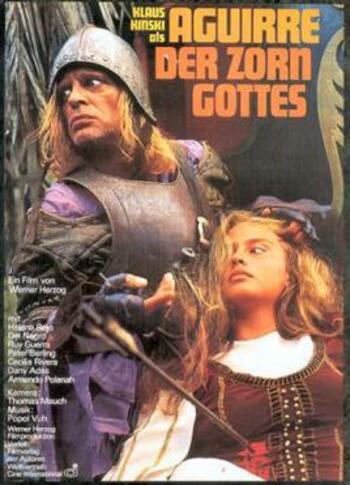
This film portrays a quest with boats on the Amazon river, adventurers
that throw themselves at unknown lands only based on faith into the
myth of the El Dorado. The El Dorado is mentioned in the beginning as
something invented by the native people as a defense against invaders.
In this, everyone is possessed by their illusion of grandeur, bestowing
themselves titles and lands they do not actually own. Yet, no one is as
filled with it as Aguirre, self-entitled conqueror and wrath of god over
the world.
A theme that is recurrent is the unforgiving nature, along with the
native people living in harmony within it that have been uprooted and
humiliated. These people, omnipresent but almost unseen, or seen only as
slaves in the movie, are taking revenge through poisonous arrows. The
whole piece is filmed like a documentary, deep in this wild forest,
with imposing shots of nature.
Aguirre, is a crazy leader that seems to force his way to get what
he wants, portrayed as an almost drunk person, drunk on power. He has
witty comments that push others to act like he wants, they fear him. The
dialog throughout are all short, we're only seeing the journey of the
characters as they advance towards hopelessness. The priest is the ironic
narrator, sometimes siding with the conquest by saying that god is with
the strong and that everything is in our imagination, yet at the end
finally knows they're going to die for nothing.
The insane tragedy is that no one is as blind as Aguirre, like a Don
Quixote he pushes through. He doesn't even realize that he's sending
everyone into chaos, on the contrary he thinks he getting closer to
the goal. Indeed, everyone seems to fail him, and he's left alone to
rot in the end scene. The image of the monkeys is pertinent, as its
first shown to say that everyone else is asleep without realizing it,
which is when he suggest to Perucho to fire the cannon to clean the rust
from it, which is his way of revolting and taking back leadership of
the group. The same motif is used in the final scene where he is left
alone with countless monkeys playing around the raft and on the cannon,
the monkeys symbolizing that everyone is asleep but him. Yet, we as the
viewers know that ironically he's the one still dreaming.
Dogville 🔗
2003 • Denmark/United Kingdom/Sweden/France/Germany • Lars von Trier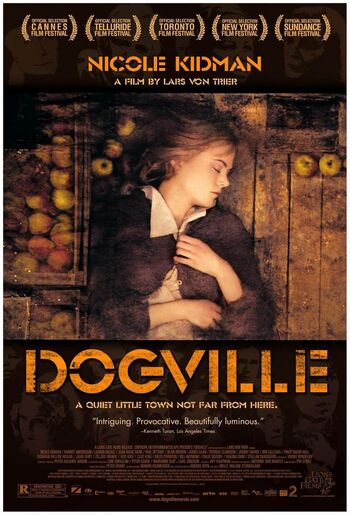
A filmed part of von Trier's incomplete USA – Land of Opportunities
trilogy. It is shot like a theatre scene, all in a single place, devoid of
anything but the characters in it. The houses are transparent, no walls
to hide anything, signifying we can see through the people's hearts. The
only things we see are the objects people interact with. Even the dog
isn't present, but a marking of it, there's a marking for everything,
symbols and language is what ties everyone in this town together.
This is all marked by the town's philosopher, Tom, the son of the town's
physician, but now act as the spiritual leader of the town. This denotes
a transition from healing the bodies to healing the minds, a much harder
challenge. Tom invites a young woman in need and wants to use her as
an illustration of the sociability and civility of the town's people,
their good heart. This starts amicably but then devolves into harassment,
blackmailing and abuse as they slowly notice the power they have over her,
as soon as they realize that there is no consequences to their
actions. The town's people revert to their animalistic nature and act
with the refugee as if she was now an object, a prisoner, a tool to all their carnal,
sexual, and disgusting desires.
It goes to show that the illustration of the philosopher failed miserably,
and this is then resolved through force, through a moral leviathan that
puts back everything in order, as the father of the girl comes to town
and murders everyone. This is prefaced by a deep discussion about faith
in humanity, about moral dilemma, how every actions should have its
consequence because otherwise so many would abuse the situation and lose
their moral values.
The leitmotif of the dog reappears at the end, but this time it is real,
the only living thing left in town. It is then followed by a slideshow
from real people during the American great depression, a deep critique
of how this society operates.
Wild Strawberries (Smultronstället) 🔗
1957 • Sweden • Ingmar Bergman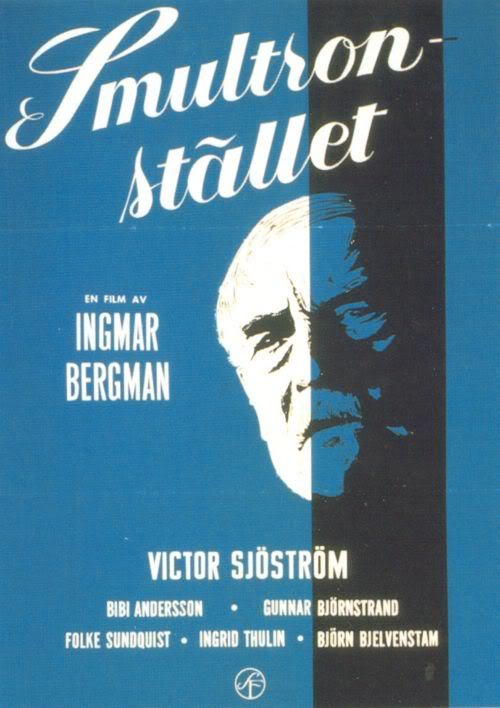
What does it mean to live a good life, what are regrets, how do we want
to be remembered, what's our legacy, is the facade and the mask we're
wearing really what others are seeing?
In Smultronstället, Bergman takes us on a trip, both figuratively and
literally, by having the main character, the bitter and grumpy Isak Borg,
try to ease his mind with a car trip after a nightmare about his own
mortality. The path he takes brings with it pieces: people, places, and
memories, all linked together. Indeed, he both travels through space and
time, the past and the future, similar to a Scrooge story. The ambience
is one of constant movement and uneasiness, going nowhere but somewhere.
Yet, he knows that at a specific time he has to be at the ceremony to
be awarded the degree of Doctor Jubilaris 50 years after he received his
doctorate as a doctor general practitioner, something he's been looking
forward to, as the introduction let us know, he's put more into science
than anything else in his life.
The movie has three dreams, each enclosing the start, middle, and end
of the movie and linked to changes in the state of the character. The
first dream is a solemn one, a nightmarish empty city is shown through
catastrophic distance shot as Borg walks through it haphazardly. In that
city he's faced with a clock that doesn't have hands, signifying the
lack of time, and finds no one, no one but himself in a coffin. In the
second dream, halfway through the movie, he is faced with the anticipated
event of the Doctor Jubilaris, in which he's criticized by the examiner as
being a sham, a fraud, and that the real examination is that he is 'guilty of
guilt'. He is not able to read the scriptures on the wall that are clear
to others, saying that his main duty as a doctor is to ask forgiveness. In
that dream he also gets insight into misunderstandings of his past lover,
and how his wife really perceived him: as cold and heartless. In the last
dream, the closing sequence, he falls asleep at his son's home and after
his ordeal is finally at peace, joyous, dreaming of a family picnic by
a lake.
The car rides initially unconsciously took him to a place where he grew
up as a kid. Somewhat a peaceful place, somewhat as to also make amend
with the past. It isn't his home, but a place that feels like home, the
place where he lost trust in love when his brother stole his lover. Yet
this is never mentioned explicitly in the movie, but only alluded to. When
we visit a place where we used to live, it cues us to revert to who we
were before, maybe before he got hurt. This is also where the Swedish
play on word 'Smultronstället' comes from, it signifies 'a hidden gem of
a place, often with personal or sentimental value, and not widely known.'
The people that are found on his path and follow him on his trip all
symbolize something. The movie mostly takes and is driven by a thread
that links all these characters portrayed. They each symbolize a type of
relationship. His daughter in law has issues with her husband related to
child rearing; they do not want to pass down the pain of life to their
children and are torn about the decision. Borg makes amend to this by
helping in resolving this issue between the lovers. His uncle and aunt
are joyous and playful, an inspiration. The young couple composed of one
woman and two men is a representation of the conundrum of religion and
modernity. The men fight for her, on both end of the spectrum about what
is important in life. The vitriolic couple they had a car accident with,
which reminds Isak Borg of his own unhappy marriage. They're kicked out of
the car. The couple at the gas station, which are intimate and happy. They
remind him of how others thought of him before and his actions. Finally,
his own mother, cold, alone, and distant because of senility is a
reflection of himself and what he could be. This is emphasized by the
clock without hands from his first dream that is also present here as
a memento, a realization that he should take action and accept his
mistakes.
He finally makes amend, make peace with the few people he's connected
to in his life. When the Doctor Jubilaris event takes place, it doesn't
seem as grandiose as he had thought, but is banal. He realized there
are things more important in life.
The snow queen (Снежная королева) 🔗
1957 • URSS • Lev Atamanov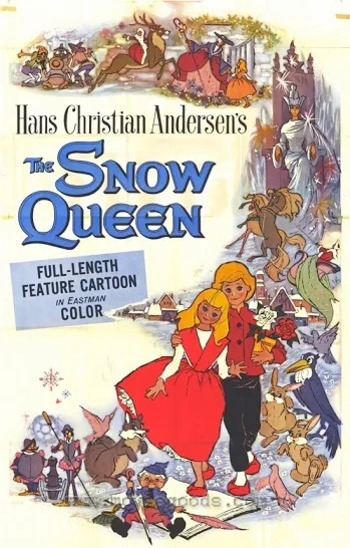
This fairy tale movie, is presented as a fable from a book narrated by
a small creature, a sort of funny gnome, this is used as the framing
device. The animation piece is filled with beautiful and bright colors
that are almost magical, all features are exagerated. During the first
part of the film they are almost ephemeral, with smooth edges, that is
until Gerda arrives at the snow queen's palace when this all turns to
torny, color colors, and sharp well-defined edges. The dimensions of
the universe are emphasized by shots from afar, putting focus on the
immensity and distance traveled by Gerda to find her lover Kai, along
with all the cultures she meets in between.
As she moves in this world, the only recurring words are 'thank you'
and 'oh please', Gerda almost being helpless, passive in her action, and
only having her love as her major attribute. Yet, this is fruitful as the
rules of nature, and most importantly the feelings of others, are touched
by it and they ply to her will out of goodness. The only real effort that
Gerda has is in the last walk in the snow, feet burning without shoes,
as she gives everything. Meanwhile, the snow queen's heart is made of ice,
out of loneliness and spite for the warmth of the living beings, jealousy
consuming her. She also tries to shape others, however she is active in
it putting sheer force, grandiose mannerism and an otherwordly presence
into it. Yet she can't bend the rules and is isolated instead.
On a first watch this seems like a simple story of the duality between
good and evil, yet the queen is far from the destructive and disorderly
being we make her to be. She appears to act more out of loneliness,
a will to possess a relationship, than out of anger. We can't help but
make the relation with the cold war and the geopolitical tensions of
the time, the winter wishing for a spring. The life's ups and downs,
emotions, flowers blooming again.
The pass (Перевал) 🔗
1988 • URSS • Vladimir Tarasov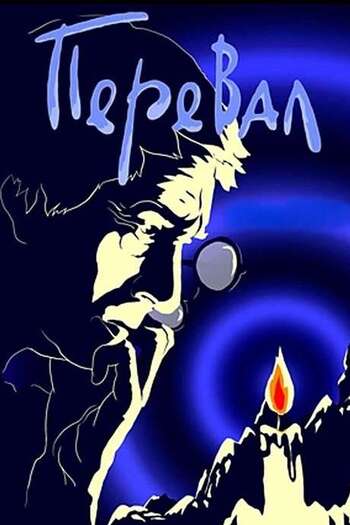
On a desolate planet, we are welcomed by survivors that are putting their
hopes in the younger generation to find something, what that something
is slowly reveals itself. The snow isn't snow but radiation dust from
a ship sent from a planet afar with the distant hope that it'll be the
seed of another planet. This is indirectly whispered through the shadows,
the portrays of light and puppets of human figures as they dangerously
and painfully walk this wasted land, only to be suddently caressed by the
colors when entering the ship, dancing through the dreams of the past. The
gentle breeze of the fluid animations takes our breath away.
The story hides itself within the lines, nothing is said directly but
we can infer it. The characters personality is unimportant in their quest,
all that is apparent is the old vs the new, the regrets and errors, and
wanting to make it better for our descendants, a beacon call in the dark.
The Wonderful Story of Henry Sugar 🔗
2023 • USA • Wes Anderson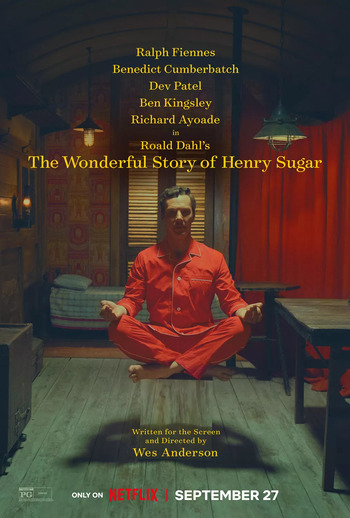
A fantastic fable about belief, determination, and fate. It is filmed
on an almost non-moving camera, so-called dolly shots, presented with
beautiful green screens overlapped with decors that smoothly change in
front of it in a frenzied and fast-paced dance. The colors follow the
decor, overly saturated, almost cartoonishly so. Similarly, the classical
music that accompanies it is almost mystic and fantastical. The story
is presented by characters that self-narrate, in a comedic and ironic
manner, which makes it so lighthearted to watch.
Overall, a well-executed performance, well recommended.
The Banshees of Inisherin 🔗
2022 • Ireland • Martin McDonagh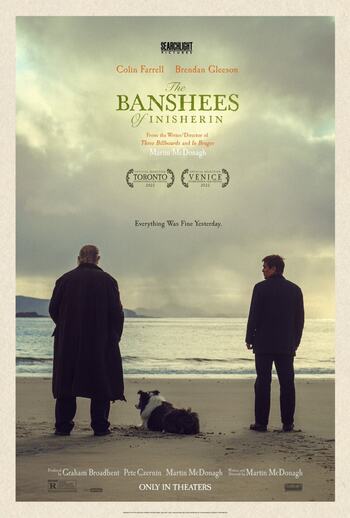
Time passes quickly, and the sudden realization that we're at our end might make us change our habits, and destroy our relationships. What we've found was pertinent might not be the next day. This tale, with its hidden message about the Irish civil war, captures the sentiment of self-destruction and deep pain about life and togetherness. We're assaulted with grandiose and picturesque frames of the almost empty wilderness of the island, which reminds us of the loneliness and smallness of the characters, that probably only have a minor place in this world, with their mundane and 'boring', so ever repeating lives.
House of Games 🔗
1987 • USA • David Mamet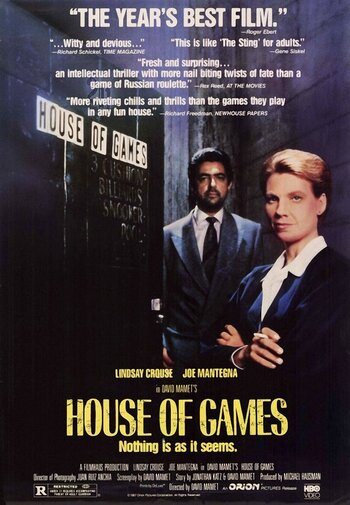
A tale of the society's underside, with it deceptions and bending of the rules. It can be seen as a sort of Dr.Mabuse twist.
Blue Velvet 🔗
1986 • USA • David Lynch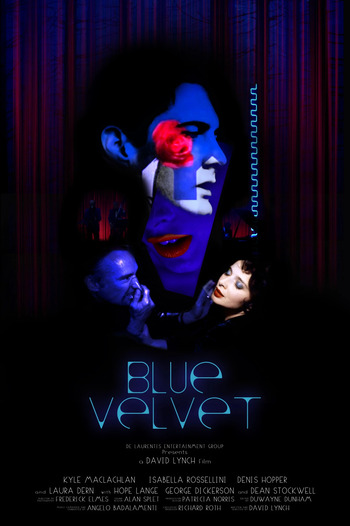
Blue Velvet is a pure experience of the anti-hero narrative and
characters. The movie's main theme is a masochistic curiosity, a passion
for looking under the cover and be tempted by life, sex, family, and
society. In that setup, nobody is perfect, all characters have their
flaws, are unclean, lying and living through false expectations of each
others, in a sort of chaotic dance where everyone constantly hurts. The
abuse, temptation of abuse, and repetition of it is omnipresent, the
characters almost laugh at themselves by portraying and talking of their
own troubles of insanity.
The use of light and darkness adds to this equation, the day is more
inquisitive and accompanied by the dream of the birds that the girl
mentions, a will to find some good in the complications of the
world. Meanwhile, the dark setup is where the rampant corrupted society
hides, literally represented by the curtain that flows in a manner
that says: 'I fear that someone will find out what I'm doing, I'm
ashamed'. The paranoid stairs are the path to dark sins of the underworld
and always filmed from above, we're accomplice in the perverted
voyeurism. Always the anticipation, amplified by a leitmotif music that
is drowsy, almost hurting.
This dark world is also represented by insects all along the movie,
from the ear, to the bug-man spraying, to the mask that frank carries,
and to the final scene where the birds (light) eat the bug (darkness).
Finally, we cannot dismiss the theme of family abuse, that is all over
this piece, along with a sort of Oedipus scenario.
Eraser Head 🔗
1977 • USA • David Lynch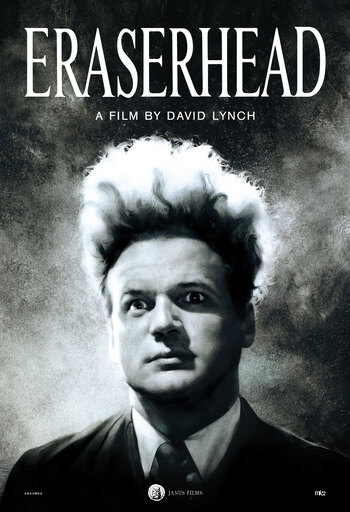
On the surface this is a horror about an apocalyptic industrial world in which diseased creatures breed humans who confusingly think they are their offspring. Yet, the rhetoric goes deeper, it portrays industrialization, where the individual is only a tiny piece of, uncomfortable in this environment, displayed by the long distance shot of single persons traveling the world, of windows all closed shot to the world, and zooms on industrial equipments, zooms from darkness to light but often only to darkness and dirt, and there is only 'warmth' given through radiators in these hermetic rooms. The whole piece is filmed in black and white, playing with shadows, and mostly a sentiment of being out of place. The piece also touches creation and procreation, in a world devoid of humanity, the character of Henry is sort of doomed to create machines and monsters, nothing in between. This is portrayed through the constant repetition of the spermatozoon that seems to frighten him, even in his dream, women are seen as monsters, yet he can't help but seek them, until in one of his dream his head is cut off, and nothing is found in it but a machine that makes pencils. The same dream portrays a girl dancing on a show, lights on her, and 'attraction' as the slithery reproductive seeds spills on her. His child, is sick, monstrous, and also empty of flesh, as is shown through one of the last scene where he kills it. The films ends with him embracing his horrible dream girl, in the light of the show, embracing the horrible nature of this industrious world where no real human is there.
Under The Silver Lake 🔗
2018 • USA • David Robert Mitchell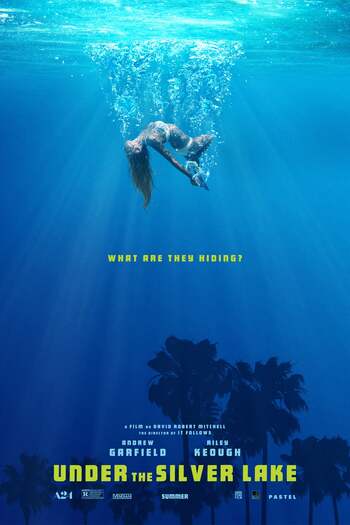
Are we only pieces in a chess game? That's the recurrent theme of this piece. Delving into our carnal and animalistic nature with the recurrent leitmotif of dogs. We're overwhelmed with the inescapability of human nature, from raw desires such as sex. Yet, we hope that there's something more, something deeper, and this crescendo of hope clashes with reality: we're all but dumb apes. Should we embrace it?
Stranger Than Fiction 🔗
2006 • USA • Marc Forster/Zach Helm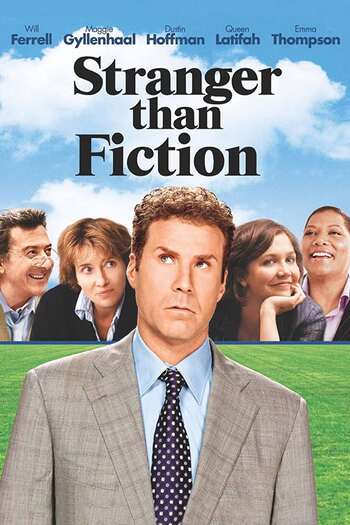
A twist on a Truman Show story with Dark City. But sort of breaking an imaginary fourth wall with the narrative writer. It deals mainly with the concept of fate, yet when this fate is accepted the ending goes toward a Deus Ex Machina.
Le Fabuleux Destin d'Amélie Poulain 🔗
2001 • French/German • Jean-Pierre Jeunet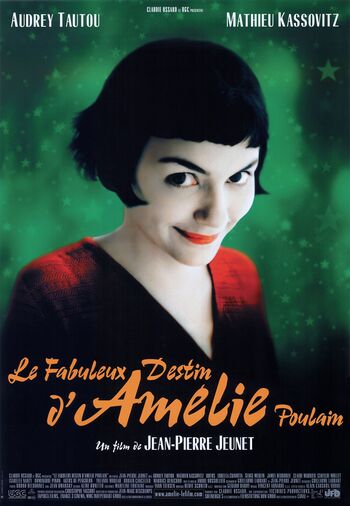
A film that portrays another view on personal intimacy, a voyeurish one, but one that shows the beauty in the small everyday affairs, the ordinary. It also deals with living through the look of others, and then finally knowing ourselves and blooming. The narrator itself is a curious being, and the mise-en-scene and coloring of frames adds a vertigo effect to the whole mix.
Encounters at the End of the World 🔗
2007 • USA/Antarctica • Werner Herzog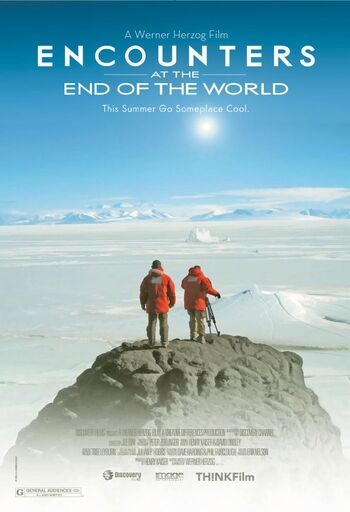
A mesmerizing documentary about Antarctica and the spirits it captures. Its story is told through the characters that find themselves on one of the most remote places, away from civilization, yet bound by the same dream and convictions. Each of them with their stories, which Herzog wistfully is able to capture through a series of well picked questions. All of this is accompanied by the grandiosity of the place, yet humbling. Everything is a spectacle of the senses, almost religious.
Naked Lunch 🔗
1991 • USA • David Cronenberg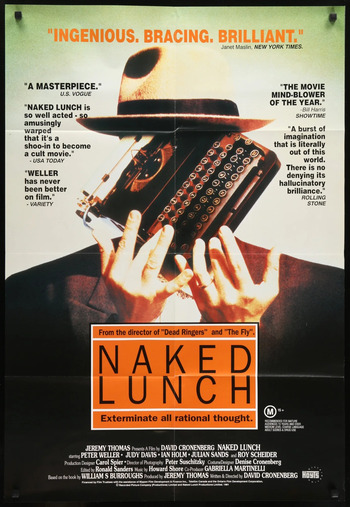
This film deals with addiction, hallucination, the need to belong and be accepted for what we do, and yet not finding it and getting stuck. The non-acceptance of our sexual identity.
The Night Digger 🔗
1971 • UK • Alastair Reid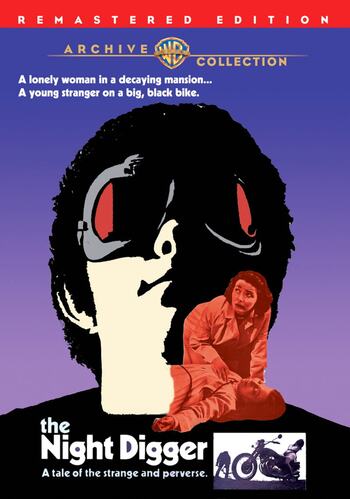
A horror/thriller fable, going from a light, almost ridicule situation,
to a more deeper meaning. This is achieved through a tempo change halfway
across the movie. One one side, we see a woman that has lost the light
and youth, so-called spinster or old maid, trading it for care but that
craves for vivality and freedom. On the other side, we see a man that
feels defficient, shunned since childhood about his sexual abilities,
and has become a deviant, a murderer of anyone he lusts, instantly
represented and captured by his motorcycle.
The movie carries a metaphor for the personal trauma that are often
relived within a relationship, from love avoidance to love addicts. The
disease of each others intermingle and ruin the relationhips. On one
side it literally kills it, a sort of Oedipus tale. Each facial
expression, each torturous feeling is captured closely by the camera.
Once the two characters find each others and fill their holes, the time
slowly compresses, changing from the chaotic and cramped dusty brown and
gray colors, to more picturesque scenes, pastel colors and empty fields
of the country side. Yet, the patterns always reemerged if not truly
healed. One became a motherly figure and the others the representation
of vigor and temerity, but what actually happens is a theatre of issues
and disfunctional people trying to make a relationhip by destroying
one another.
Taxi driver 🔗
1976 • USA • Martin Scorsese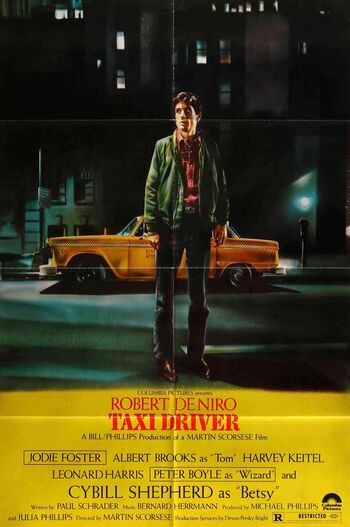
This movie directly gives you a malaise, and does everything to keep
you in this dream-like state of discomfort, be it through the dizziness
of the camera angles, the slobbering and fluffy continuous jazz piece,
or the recurrent scenes where everything seems redundants and passing
without our awareness. We're bound to the feeling of being lost and
hopeless just like the main character that mainly feels it through his
insomnia which then translates into pranoia, voyeurism, and others. The
world passes him by, and he observes it, deeply wanting to attach himself
to it, find meaning, to then realize the corruption and decadence he
has been noticing has encroached on him too.
He will want to rescue and fix the dirtiness, both in the decaying city
and in him. After an existential crisis scene, which clashes the world
of the day where corruption is more hidden and blinding to the sight,
and the world of the night where the scums get out. The characters fails
the attempt at being an antihero, but then finds justice and meaning by
rectifying some things in the world of the night.
La Planete Sauvage 🔗
1973 • France/Czech • René Laloux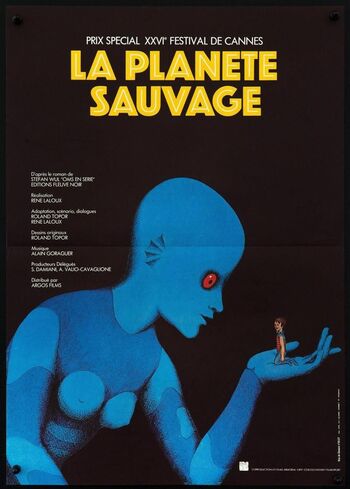
An hypnotic animated movie about humanhood and its place. Every frame
is hand-drawn in a style similar to Dali's surrealism, we feel uncanny
at the strangeness of the world described, humans only an infinitely
small part of it. The music is also dizzying, an ambiance of awe sets
in. Since humans are in the background, the higher beings are instead
the rulers of this world, the ones that actually understand it. Humans
are only insects or toys, and we see everything from this perspectives.
The film puts the two creatures face to face, the higher being emphasizes
living in sync with their organic world, meditating, and even merging with
their environment, procreating through a dance of statues. Meanwhile,
humans are enticed by learning, all rotting knowledge and tools, and
practical structural things.
Even though the story is told from the first person narrative, the main
character quickly disappears and everything seems more like a subjective
documentary.
Soylent Green 🔗
1973 • USA • Richard Fleischer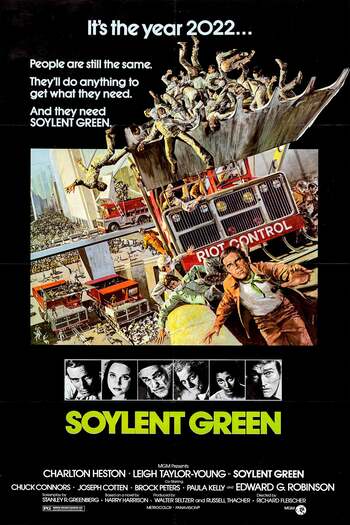
A dystopian tale of human nature that takes us into a future of scarcity,
overpopulation, pollution, chaos, and distrust. We're faced with two
parts of this society, the secretive and pristine elites, living in
high and bright worlds, viewing the world as objects to their desire,
as encompassed by beautiful women being viewed as 'furniture', and
controlling the masses as if they were beasts. Meanwhile, the lowly
mortals, living in the greenish hue of the pollution, overcrowded and dim
apartments, and subject to daily curfew. In contrast with the above two,
we're faced with the past, that percolates through the older generation,
that is dreaming of the past world, but feeling an intense guilt about
the actions that led to the current situation. It's this very generation
that serves as fuel, literally food, for the masses of the new world,
a religious-like experience of transubstantiation. The movie uses the
narrative of the police detective, in a thriller-style, to uncover the
different facets of this society, a bridge figure that can navigate in
between cracks.
All along the movie, frames emphasize and zoom on food: the subjective
experience against the sustenance aspect. It also achieves the same
regarding the concept of space, living space, crowded space almost
animalistic, vs freedom, brightness, legerity, pristine, etc.. The ending
words of the protagonist puts all this in perspective, comparing the
people as cattle for their meat. One can definitely extract the clear
alarm message behind the movie, a wake up call to human stupidity.
La Grande Bouffe 🔗
1972 • France/Italy • Marco Ferreri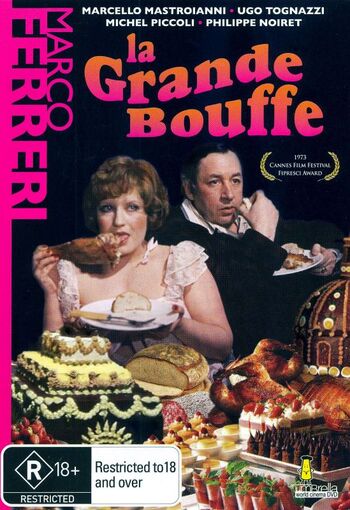
Can there be too much of something good? Definitely, when you have everything that the animal in you needs, and you still ask for more, you become carnal of instincts. Yet, you are unfulfilled, but this is the only thing you can find to satisfy you, an orgy of sensations leading to death and making you want death, escapism of reality. The mother figure is omnipresent all over the movie, accompanying the childish creatures, each representing certain crass but wealthy of society (legal, entertainment, travel, food) towards their destiny, with all the vices and carnal nihilistic impulses. An absurd ballet of consumer culture, in which only a single imminent jingle plays to make us uncomfortable.
Hedgehog in the Fog 🔗
1975 • URSS • Yuri Norstein
An animated childhood tale that feels more like a horror story. The work on the ambience, sound, and effects is mind blowing.
Persona 🔗
1966 • Sweden • Ingmar Bergman
Persona is a chef d'œuvre, as they say, the Mount Everest of cinematic
analysis. In appearance it is an avant-garde psychological drama with
hints of psychological horror. The story of Alma, a nurse, and her
patient, a well-known actress called Elisabet that suddenly stopped
speaking after a stage appearance, for fear of laughing instead of
rehearsing, and other reasons that are unknown.
The enigma then unfolds into 3 places the hospital, the cottage, and the
beach. The nurse, unwillingly taking the initiative to cure, at all
cost, the ailment of the actress. Furthermore, the two characters slowly
merge into one another, the actress a silent mask of the nurse, a sort
of Dr.Jekyll and Mr.Hyde situation, of secrecy vs reality.
In a way, the films comments on itself as it plays, the head of nurses
directly speaking what's in the mind of the others.
There's a play around the concept of having an actress be the mask of
the other, always studying the movements of the nurse, a mask that only
has failure in its sleeps, but that never truly sleeps and drive the
other crazy.
All along the movie is the subject of deep horror or realization through
images such as the crucifixion, a spider, and the killing of a lamb,
be it sacrifice, victimhood or the end of innocence. A hidden depth,
such as self-immolation and destruction.
In the movie there is almost no one talking but the nurse, we live
the experience through her, yet the other is omnipresent, looking, and
always with her laughing smile, studying the mistakes, but invisible
and yet powerful. The camera follows along at eye-level, intimate with
the character, never above or under, but following closely the theatre
unfolding in uncomfortable long shots. Halfway through the movie the
real chaos happens, and the roles swap, the nurse feels like her life
is merging with the Elisabet. This is received with violent emotions
and actions. The anger bursts and she wants to hurt Elisabet just like
she would like to hurt herself. It starts with broken glass, the mirror
of the self. When Alma tells Elisabet that she is a terrible person,
Elisabet runs away, but Alma chases her for forgiveness, and later looks
at a picture of the Jews arrested in the Warsaw Ghetto, somehow feeling
the emotions in the eyes of the people. Are we diseased individuals to
hurt ourselves like this?
The words of the nurse don't make much sense anymore, they get mixed up,
as if they were coming from nowhere, her individuality dissolving.
A dream-like scene happens where the husband of Elisabet visits
and confuses Alma for her, and Elisabet keeps starring at them, as if
invisible and non-existent. It's uncomfortable, and expresses the true
mask, a sense of being out-of-place, of playing a role and wanting to
run away from your skin. Similar scenes are spread across the movie,
with a hint of self-hatred, regret, and wanting to change the past.
We're immersed in Alma's world through the sound of the waterphone and
scratches, horror movie instruments. Long troubling shots that let us
reflect on what the characters are feeling. And the scene where Alma
dictates and criticizes Elisabet's life and she frown, played twice and
swapping faces, slowly zooming in on their emotions.
The sacrifice is then offered to Elisabet, like a vampire, she
consumes the blood of Alma, and now she is soothed and disappears as if
non-existent. The nurse can then continue her life, her mask being put
to the side for a while.
Surprisingly, there are almost no manly figures in the movie, only the
husband as a phantom-like figure, and the supposedly son of Elisabet
that appears in the intro and outro.
The movie ends on that note, the young boy seeing the blurry image of
two women that merge together: 'giving birth to something without wanting
to, just for its image', and the child resulting from this action itself
looking at their image.
The Seventh Seal 🔗
1957 • Sweden • Ingmar Bergman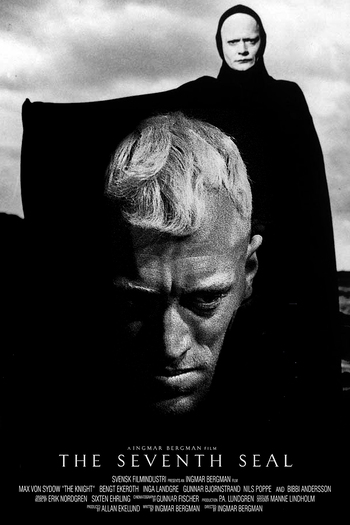
Watching this feels like traveling, or moving along in a museum of medieval art. Everything is carefully placed to have its significance and reflects a middle age theme that went along with the plague. We're especially taken aback by the conundrum of the two faces of reality: life and death, and it's continuity.
La Guerre Des Boutons 🔗
1962 • France • Yves Robert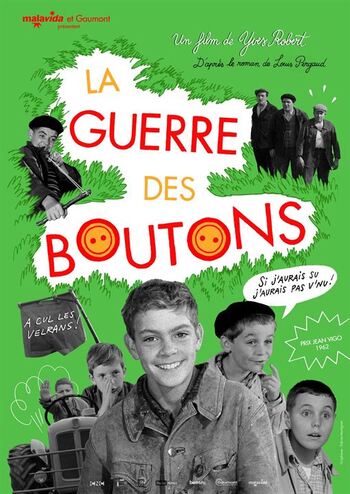
What is it like to be young and careless, hope for freedom and slowly
learn what it means to live in society, to be part of something
greater than oneself, a nation with laws, respect, and equality. Even
if learning this is through 'fake' violent play, often portrayed with
bravado music and distanced camera shot showing the powerfulness and
craziness of war, that is often attenuated and contrasted with moments
of tenderness and oxymoron, with the camera accentuating the playful
nature of the interaction. Realizations that you are always part of it,
even with the recurrent motif of the movie 'if I had known I wouldn't
have come'. The movie beautiful interfaces the world of childhood and
adulthood by gradually transitioning in the narrative, until the worse
is done by the protagonist, and the adults are portrayed with similar
traits. Goes to say, we're all humans after all, with our flaws.
We also see the paternal and maternal figures on both ages, in childhood
with the brothers Lebrac and Gibus, with Lebrac's protege's Marie Tintin,
and in adulthood with the interactions of the parents.
The Birds 🔗
1963 • USA • Alfred Hitchcock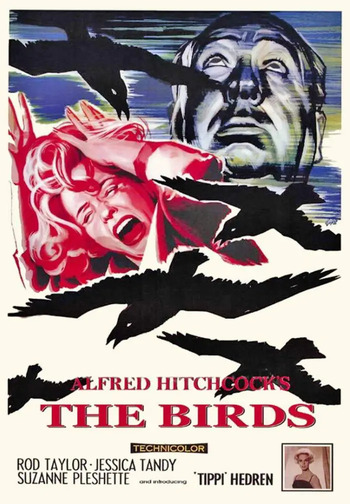
The conceptual framework of this piece is the base of so many of today's movies. An impending doom and gloom that is omnipresent and approaching, along with people's social fabric evaporating and all that it implies.
Vertigo 🔗
1958 • USA • Alfred Hitchcock
A twister thriller that takes 3/4 of the movie to build up, and then explodes in a 15min mind-bending ending.
All 🔗
1902 and beyond • Spain/France • Segundo de Chomón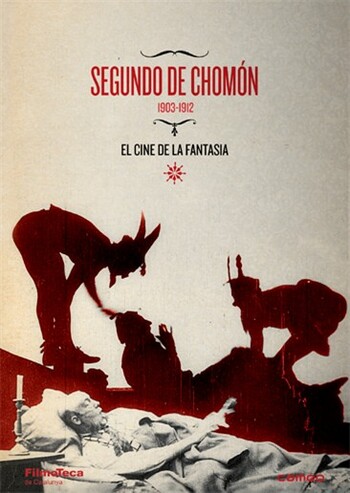
Imagine a world before what we currently consider 'modernity', before the oil industry, where traveling was an excursion, before computers and social media, before globalization, when Thomas Edison was stil alive and electricity made its debut, before any world wars. In that world, de Chomón was an illusionist, using films as a form of magic show, extending the limit of what is possible. A must watch collection of shorts.
Stalker 🔗
1979 • URSS • Andrei Tarkovsky
A movie that reverberate and echoes of the aching of living, the paradoxes that it implies. What are dreams, where do they lead, why pursue them. Is the adventure what matters and not what's at the end of the tunnel?
Solaris (Солярис) 🔗
1972 • USSR • Andrei Tarkovsky
A sci-fi story about the contact with another form of intelligence, which is the mirror of our deepest mind.
Shock Troop 1917 (Stosstrupp 1917) 🔗
1934 • Germany • Hans Zöberlein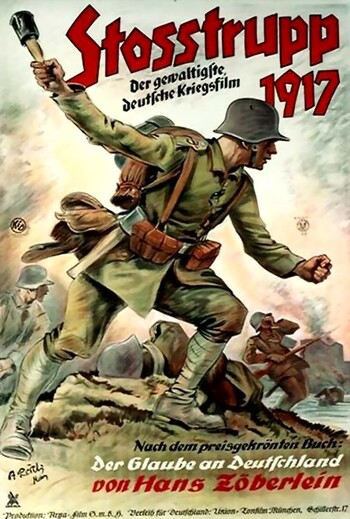
A movie about the life in the trenches, the classic war. Unfortunately, it makes you think that things would take a widely different turn today.
People on Sunday (Menschen am Sonntag) 🔗
1930 • Germany • Moriz Seeler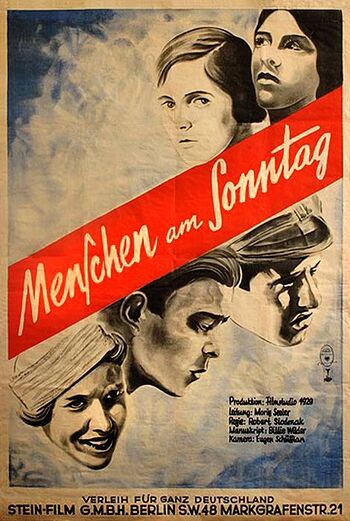
A new take on the mundane, the philosophy of the everyday life. This pseudo-documentary offers a glimpse in the past.
Long Day's Journey into Night (地球最後的夜晚) 🔗
2018 • China • Bi Gan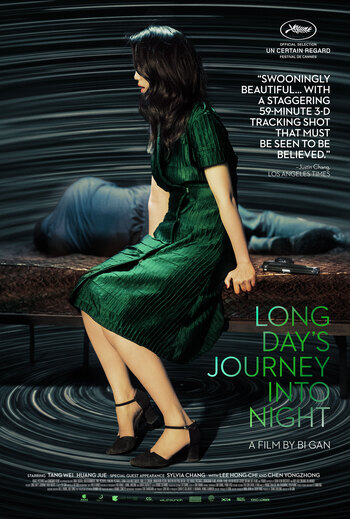
An experimental film that is dizzying. I can describe it as a wild feverish dream of surrealism. Meanings are spread through the frames, taking the form of mementos and sentences that reemerges. We're brought through memories as sequences and snapshot of times, remembering and yearning the past, yet trying to move on.
Earth (Зeмля) 🔗
1930 • USSR/Ukraine • Alexander Dovzhenko
Generational clash, the young and new defying traditions. The march of progress that is unstoppable. The fascination with what human capabilities can achieve.
Salt for Svanetia (მარილი სვანეთს) 🔗
1930 • USSR/Georgia • Mikhail Kalatozov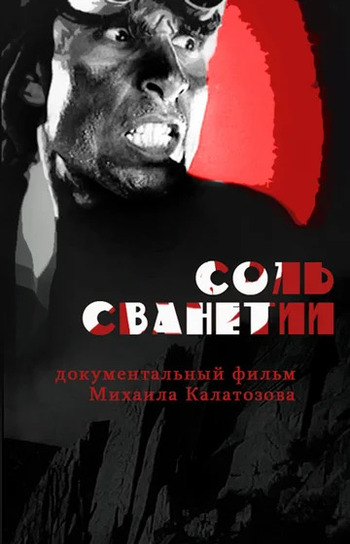
In a similar vibe to Nanook of the North, we dicover people living in remote lands and their ingenious ways to get around. A strickingly insightful and beautiful documentary, filmed in a poignant way.
Don Quixote (Don Kikhot) 🔗
1957 • USSR • Grigori Kozintsev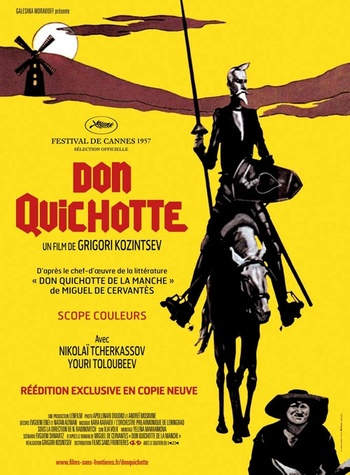
An exceptionally well-executed performance of the Don Quixote de La Mancha. It truly captures the essence of the book, transporting you in the universe, the madness of imagination of the character, empathizing with his wish for a better world. It reminds us of today's 'competence porn', of young people being prisoners of the virtual space, from video games to social media. Yet, you can't help but feel a pang in your heart when the books of Don Quixote burn in front of him, killing him at the same time, but keeping his soul within the story of his life, a meta story about being consumed by fiction and becoming fiction yourself.
Road to The Stars (Der Weg Zu Den Stermen/Doroga k zviozdam) 🔗
1950 • USSR • Pavel Klushantsev/Boris Lyapunov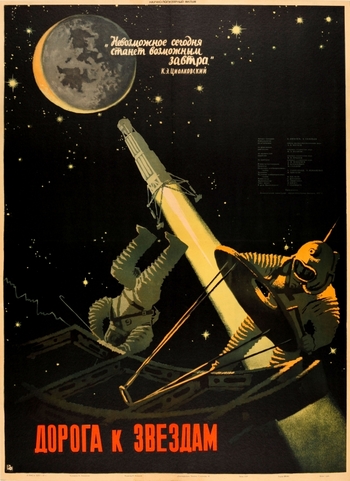
Scientifically accurate, wondefully captivating way of explaining science. You get caught in the race to the moon, the race to the stars, you start yearning for knowledge, things fit together and make sense.
Twelve Angry Men 🔗
1954 • USA • Reginald Rose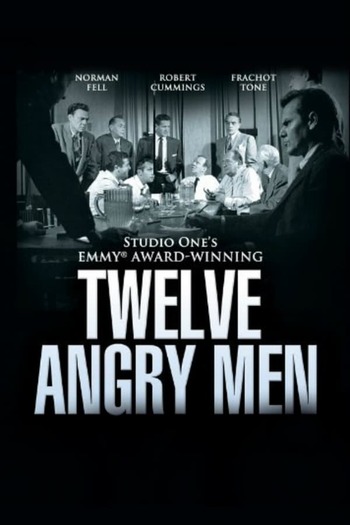
A mind bending movie. Posing a problem in all its perspectives, dicing it to pieces, making you take all positions possibles. It makes you reconsider your assumptions.
La danza de la realidad 🔗
2013 • Chile/France • Alejandro Jodorowsky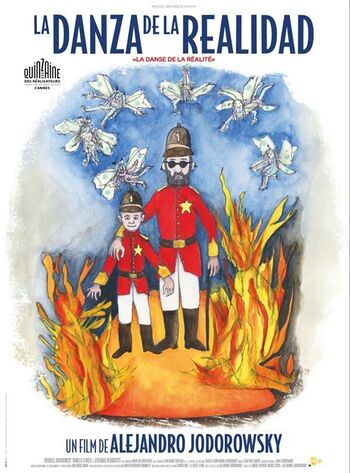
Confronted with your inane self, with life. You can't escape it, our eyes can't be closed. The cycle of suffering and relief that never ends. Prisoner of flesh, and free. Faces becomes reflections of our feelings, the heart is exposes to the air, reality as an abrasive substance, cruel, but truth as the precious revelation, yet in surrealism and dreams we can find meaning. The philosophers offering an opening to morph what we see into something less raw. A powerful movie.
La Montaña Sagrada 🔗
1973 • Mexico • Alejandro Jodorowsky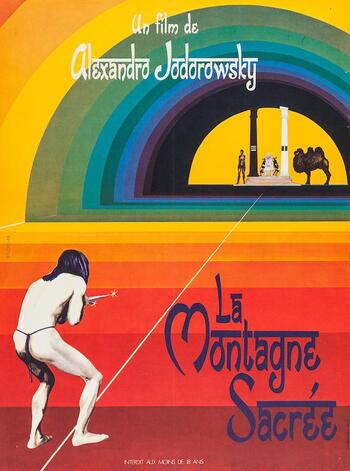
Similar with El Topo and the vibe that Jodorowsky gives, this is a surrealist story in the form of a quest for enlightenment, also full of symbolisms. The visuals are polished, invading our mind with concepts and conflicting positions. We are presented with multiple sides of human nature, of spirituality, of rough reality and how to connect back to it. The human question.
El Topo 🔗
1970 • Mexico • Alejandro Jodorowsky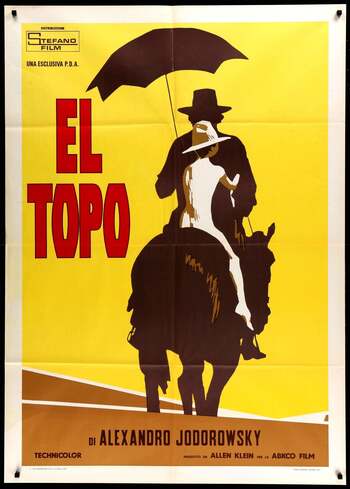
A surrealist, acid Western, movie packed with oriental and occidental symbolisms. Jodorowsky takes us on a travel to discover ourselves and the truth of our world, removing layers, one by one, and through language and images assault our senses. We're left questioning if truth, or light, or progress, is worth it.
Casablanca 🔗
1942 • USA/Morocco • Michael Curtiz
Casablanca is a romance movie, at first glance displays a love triangle between two persons who fell for one another while the husband of the woman was presumed dead in a concentration camp. It turns out that when leaving after the invasion of Paris, the woman never joins her lover, and instead discovers her husband was faking his death to avoid the gestapo and plan a revolution. The characters then all find themselves in Casablanca, Morocco, at the time a French colony, and thus considered French soil. Rick, the past lover manages an American café and somehow his past lover and her husband find themselves in Casablanca, the place where everyone goes to wait to jump on a plane to Lisbon which will take them on a path to the USA, the land of 'freedom' and 'dreams', which is ironic in today's perfective but it was what the USA represented. Over the movie the theme of war and hope are omnipresent, along with patriotism, we constantly find hints and images of that, through la Marseillaise that is played as a theme and inside jokes against the Nazis. The café that Rick manages, and all of Casablanca is portrayed as a purgatory, a 'hotel california', it's not Casablanca that is emphasized but the situation, the constant wait to leave the place. Most of the scenes take place in the café, a place where these refugees gather, a representation of the in-between. Everyone seems to only drink champagne, a drink of celebration, seemingly to the fact they're still alive. Rick's character is multi-faceted, his name changes at different time to show his evolution and how different people perceive him. While once a passionate person, in Paris, now he is disassociated, in appearance selfish. His wittiness also transpires everywhere, through a self-centered but also somewhat moral aspect. He always does the thing you'd expect, but not what you'd expect from the main character of a film. Yet this character is able to point the irony in other characters that aren't open to their own selfishness, but instead that try to show their self-centered view as some sort of bigger moral duties, it seems that Rick is able to see through that, but accepts the human situation.
Godzilla ゴジラ 🔗
1954 • Japan • Ishirō Honda
The original godzilla movie. It is filled with a sort of religious sense of mankind against or in harmony with nature. The clash between technological advancement and destruction of the environment. It is especially striking and relevant that godzilla emerges from the ocean and has been awoken by nuclear tests.
Les Vacances de Monsieur Hulot 🔗
1953 • France • Jacques Tati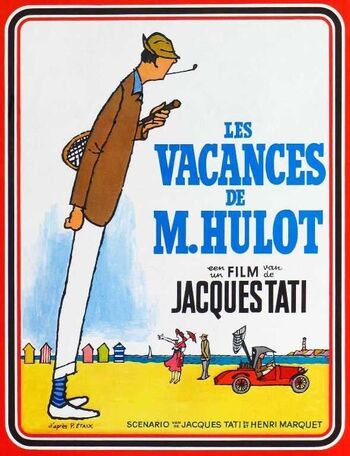
A sweet comedy that takes us on the seaside of France, in vacations. It stands on a line between Chaplin and Mr.Bean, with a main character called Mr.Hulot which clumsiness leads to open up countless adventures. the scenic views and the interactions also gives a glimpse into how the old French ways, and what it meant to be in vacations: to be part of a small group in the middle of nowhere, suddenly making acquaintances and relations, and eating and living everyday close to one another.
The Four Horsemen of the Apocalypse 🔗
1921 • USA • Rex Ingram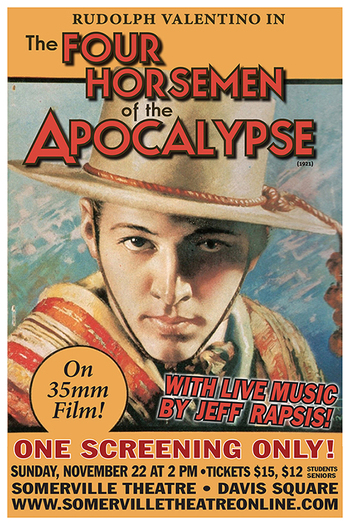
In my opinion, this is a botched movie. The story is muddied in unnecessary preamble about tango and family drama but without depth.
L'Age D'Or 🔗
1930 • France • Luis Bruñel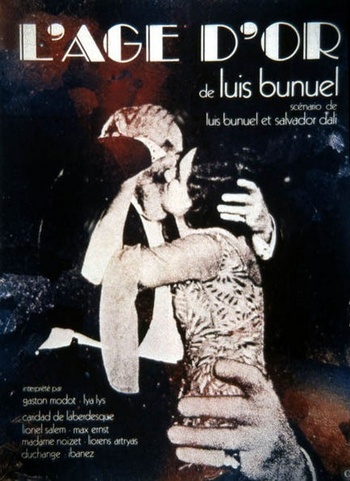
A surrealist movie about man's repressed feelings and actions suddenly brought into the world, along with social concepts and conquests such as colonialism and a sense of superiority from this upper-classiness. Everything seems to stand in the way of that, the thread keeps up until the end. Finally, remorse ensues and the character is devastated by their vision of what society's moral should be, based on religious ideals, all dictated from the 'bearded men' at the top.
La Coquille et le clergyman 🔗
1928 • France • Germaine Dulac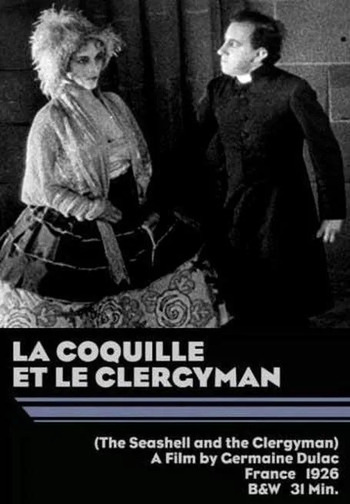
A surrealist movie that takes us in an illusion, a dream of animalistic instincts that grind against civility and conformity. We're also facing the disappointment of expectation, when we feel like something is supposed to be rightfully ours based on invented notions of work and commitment. Yet the struggle continues, and we lie to ourselves.
Les Mystères du Château du Dé 🔗
1929 • France • Man Ray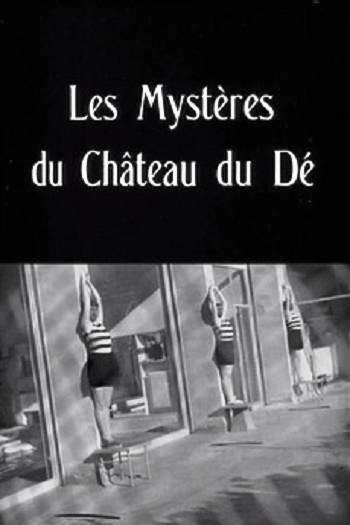
I love that dadaist piece. It immerses us in the conquest of time, against nature, the human condition of constant decay, meanwhile we try to make order but randomness and life keeps going. Definitely recommended.
Entr'acte 🔗
1924 • France • René Clair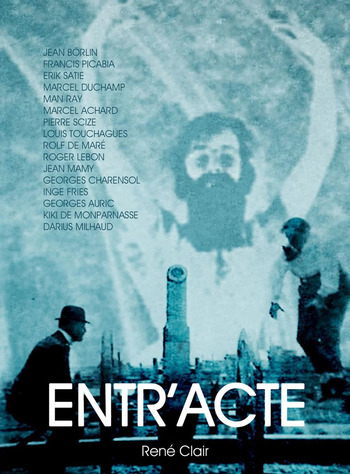
A dadaist piece that rotates around the topic of 'in-between', the seasons and cyclical aspects, discontinuations. We admire the events, in order, in reverse, fast, slow, taking them from all angles. The clashes are omnipresent, sense is at risk. To top it off, we get a sort of breaking the fourth wall in the end, turning it all into a fantastical game played by the camera magician.
The Life and Death of 9413 a Hollywood Extra 🔗
1928 • USA • Robert Florey, Slavko Vorkapich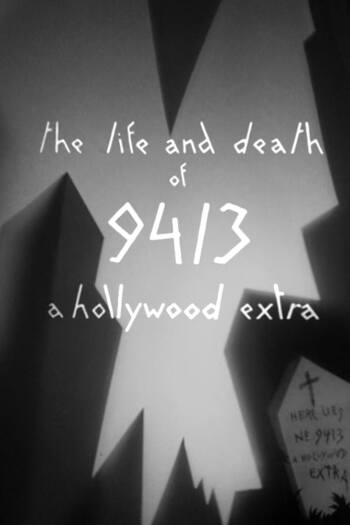
A metaphorical criticism of the USA rising new lifestyle. Torn between the attraction to materials, capitals, and on another side being forced to sell one-self to attain it, living in denial, hidden behind masks that compete against one another. Meanwhile, in this fight, we are but anonymous temporal animals.
Emak Bakia 🔗
1926 • France • Man Ray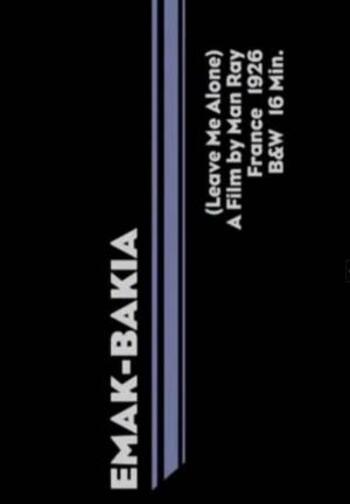
A true cinépoème, a prose via images. We're transported in this constant struggle against form, determination, and time. Incessant, chaotic, piercing.
L'Étoile de Mer 🔗
1928 • France • Man Ray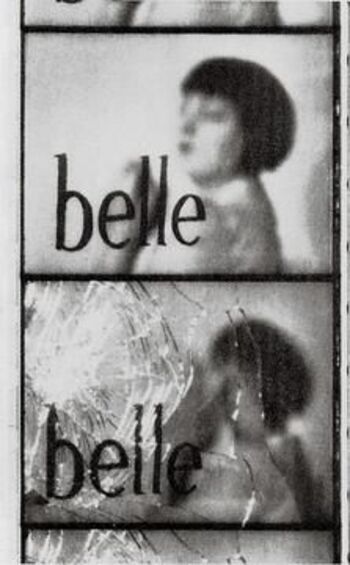
A short surrealist masterpiece, perfectly smothering us in the dream-like atmosphere. We do not understand what we feel when watching it, yet we still have a strong emotional response. The music oriental tone only accentuate the mental tension, and we can't let go. The overall feeling of resentment, past memories, and melancholic nostalgia: bitter sweet 'saudade'.
Ballet Mécanique 🔗
1924 • France • Fernand Léger,Dudley Murphy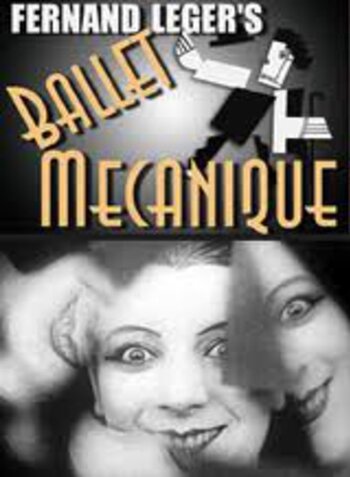
A dadaist short that pierces us with its mechanical edges. We are assimilated into the reflections and snapshots of a dance we execute. As with anything dada, we cannot help but feel the absurdity of this, the non-sense in objects and the ballet we've started with them.
Anémic Cinéma 🔗
1926 • France • Marcel Duchamp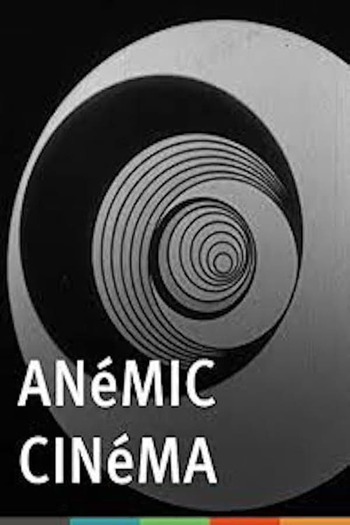
A dadaist/surrealist short that is stripped down to the essential. What is left are words, which only have meanings in their interpretation, rotating on itself, ourselves rotating on the wheel, lost.
Destino 🔗
2003 • USA/Spain • Dominique Monféry,Salvador Dalí,John Hench,Roy E. Disney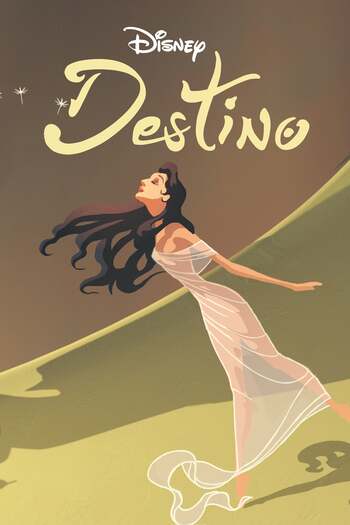
A surrealist joint cooperation between Disney studio artist Hench and Dalí. The short-movie is visually pleasing and enchanting, your mind goes on a ballet with it. However, it feels toned down, it doesn't have the piquant and emotional or mental outburst that true surrealism can trigger.
Un Chien Andalou 🔗
1929 • French/Spain • Luis Buñuel,Salvador Dalí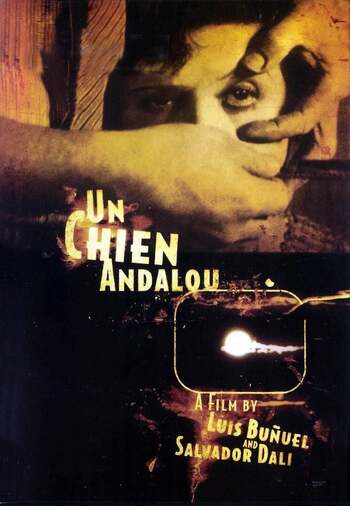
A surrealist short film directed by two genius of that movement. With surrealism you have to let go, accept being swayed by the movie. If it starts to feel like a dream, then you've learned to watched surrealism, the sort of automatic writing and associations that can only make sense in the eye of the viewer. In Un Chien Andalou, we see raw human love, from the sense to the head, along imageries of pain, pursuits of life.
8½ 🔗
1963 • Italy • Federico Fellini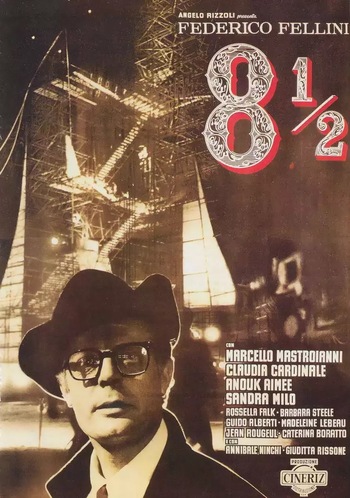
A surrealist film surrounding both a writer's block and his issues with the conception of the muse. The muse can be seen throughout the womanizing relationships that the main character has, and his inability to not fantasize about them, always looking for the ideal muse that will satiate the thirst for perfection.
M 🔗
1931 • Germany • Fritz Lang, Thea von Harbou
M is a masterpiece that grabs you from the first image. The viewer's feelings are stretched and twisted in different situations, from laughter, to drama, to fear, to vengeance, to empathy. As with Metropolis 1924, we are in a dichotomy, a clash, this time one between government institutions and mafioso as the backbone. We're seeing a tense social issue, questioning the role of legislations, whether we're falling into anarchy, the balance between the different faction in society. Who should bring justice, is mob justice good justice? What happens when the rule of law fall short for bureaucracy, theatre and ceremonies. What's the role of government in a falling situation, surveillance, parenting, mental illness. So many intricate subjects interwoven in this hectic and captivating story. I highly recommend it!
Metropolis 🔗
1927 • Germany • Fritz Lang, Thea von Harbou
Metropolis is one of those movies that joins so many nuances and subjects that it keeps you thinking about it for days. It presents a futuristic scene, similar to 1984 or A Brave New World, but preceding them by almost 20 years. The Lang's theme of destiny is ever present, mixed with a future where humanity is put in question by machines, both physical and metaphorically embodied through men working in factories, and mixed with a religious tone and class struggles. The subtle cinematic effects in the movie are sublime, it's instantly memorable. I highly recommend it!
Dir Nibelungen 🔗
1924 • Germany • Fritz Lang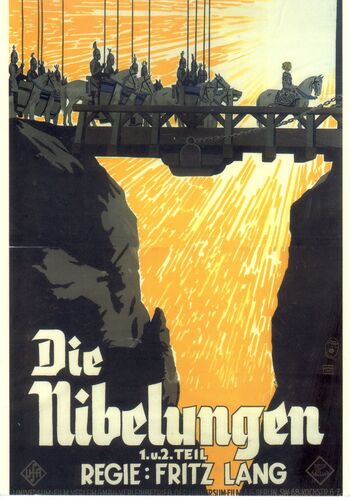
A fantasy film in two parts 'Siegfried' and 'Kriemhild's Revenge'. It definitely keeps true to Lang's signature, namely the fight over destiny, death, and reality. In the first part, we're presented with a legendary figure, Siegfried the magnificent. The person incarnates an immovable object, someone that is the antithesis of Dr.Mabuse, a good fellow that achieves his goal through sheer force and ambition, not through mental manipulative techniques. Yet, this figure disrupt the balance, just like Dr.Mabuse, and jealousy ensues. Someone wants to destroy him at all costs, and this is what happens: the invincible Siegfried falls and with him his vision of the world. In the second part, Kriemhild's Revenge, Siegfried's wife goes all the way to avenge her husband, to rectify an affront. The rage consumes her, she is obsessed with it, nothing makes sense but the revenge. However, each person of the stories has ties to one another, oath that cannot be broken, pictured as stronger than family ties. The vengeance goes beyond all that and destroys the lives of many, all until everything is burned down and she is finally satiated. Balance is restored.
The Thousand Eyes of Dr Mabuse (Die 1000 Augen des Dr Mabuse) 🔗
1960 • Germany • Fritz Lang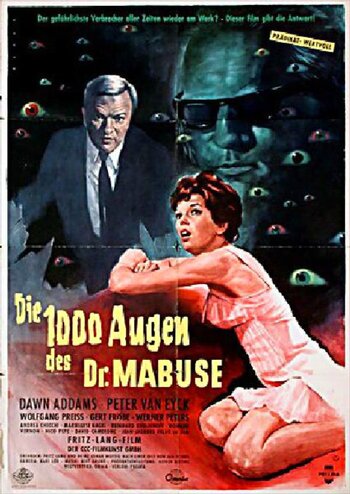
The final movie in the series of the Dr.Mabuse. As captivating as the others but ends dramatically too soon.
Das Testament des Dr Mabuse 🔗
1933 • Germany • Fritz Lang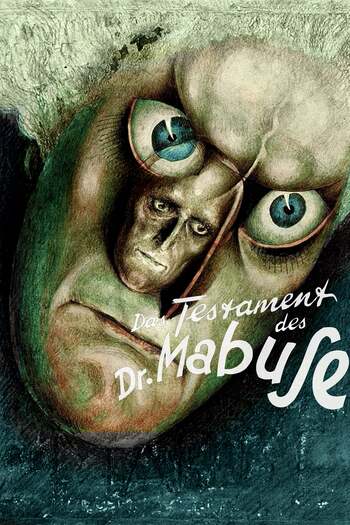
The follow up on der Spieler. We're brought in a world of conspiracy, where a mischievous evil persona manipulates events to his will, and from a distance. All cunningly to pass the flame of the 'empire of crime'. People are drawn to this malice, not because they want to, but because of their needs.
Dr. Mabuse, der Spieler 🔗
1922 • Germany • Fritz Lang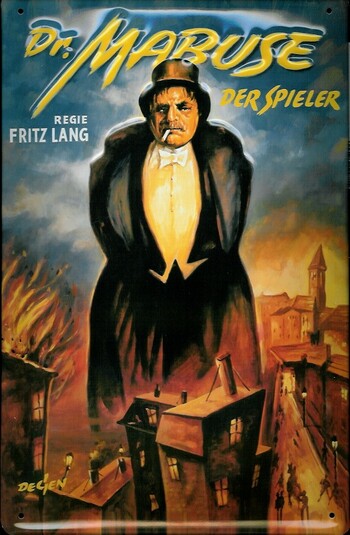
An narrative of the anti-hero, someone that is a representation of the corruption and carnality of society. The gamblers is only driven by the joy that manipulating others give, that destroying other's life can procure. This is in stark contrast with Destiny 1921 where nobody has control of the situation, the opposite is depicted as evil. Yet, the viewer connects with the miscreant, we're also blissfully loving the 'competency porn' happening — reality bends to the will of Dr.Mabuse.
Destiny (Der müde Tod) 🔗
1921 • Germany • Fritz Lang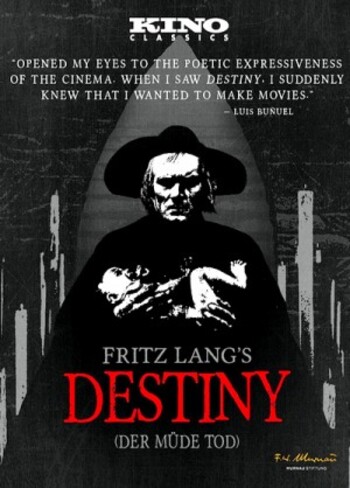
Similar to The Phantom Carriage of the same year, this is a story imbued with oriental and occidental folktales. Fritz Lang make us travel the world and empathize with human nature, but still somehow feel the dreaded fate, or destiny. The characters are puppets, yet the protagonist makes a deliberate choice on it. A hidden Sisyphus meaning within it, an existentialist question. It's funny that critics found that movie 'not German enough'.
Soviet Toys (Советские игрушки) 🔗
1924 • URSS • Dziga Vertov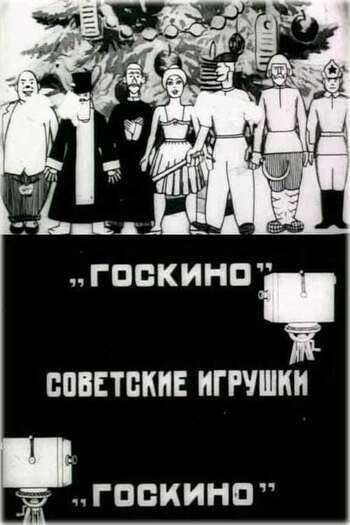
The first animated movie from the URSS, a chef d'œuvre from the artist Dziga Vertov, which also made A Man With a Movie Camera. The movie holds both a political message and a moral one. It is a caricature that transforms and morphs itself, capturing your empathy. Maybe there's a hint of post-modernism/surrealism/shinkankakuha in there?
A Page of Madness (狂った一頁) 🔗
1926 • Japan • Teinosuke Kinugasa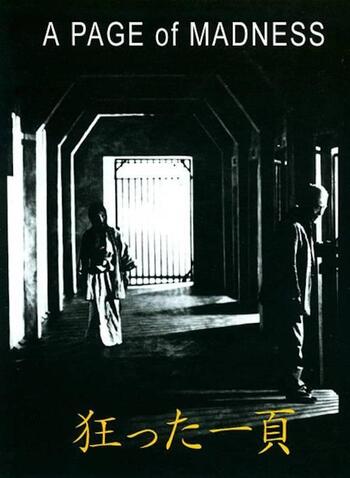
It is a treasure to observe movies as an art movement from pre-WWII era Japan. From the Shinkankakuha school, this magnificent artwork achieves its goal to perfection: Bringing the world of dreams, the unsaid, the hidden, in front of us. It joins the absurdity and bitterness of humanity, the madness in us, both metaphorical and concrete, into a dance that captures us from the first image to the last. The Shinkankakuha artists are the Japanese mental brothers of the French, Spanish, and Catalonian surrealists.
Le Voyage dans la Lune 🔗
1902 • France • Georges Méliès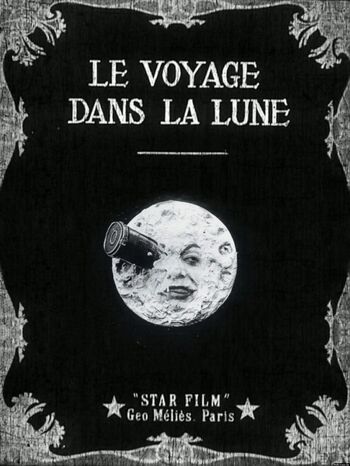
Similar to the Fée aux Choux, this is a movie that materializes imagination into reality. The author being an illusionist has been able to create the montage and impressive scenes. The comedic aspects make it reflect on colonial times, along with the theatrical dressing and bickering of men that think highly of themselves.
La Fée aux Choux 🔗
1896 • France • Alice Guy-Blaché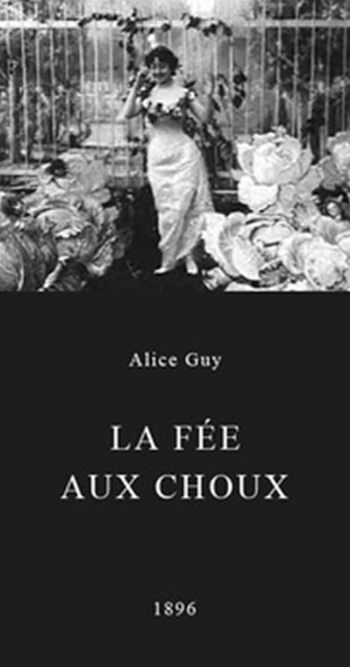
One of the first movie to take the viewer on a dream journey, show the possibility of cinema to bring fairy tales to life.
Greed 🔗
1924 • USA/Austria • Erich von Stroheim
A movie that will disturb you in your inner core. The awkwardness and unease never let go, the sort of clumsiness of Napoleon Dynamite mixed with a Swedish sense of horror. The set-up is a convoluted mesh of non-sense, raw animalistic feelings, disgust, and the environment or survival taking over logic. Definitely, a good watch!
Nanook of the North 🔗
1922 • USA/Canada • Robert J. Flaherty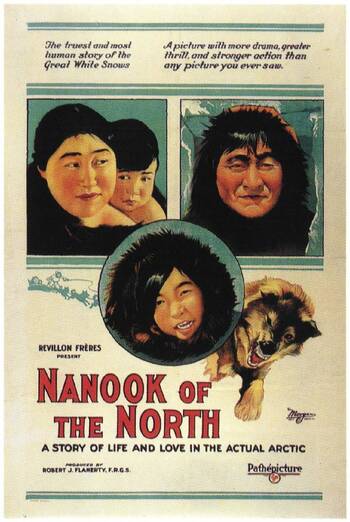
This documentary on the life of Inuits in the Canadian Arctic offers a lens into their traditional ways of life. Some have argued that during the filming the Inuits were already being influenced by the 'Western' ways, but I'd retort that it still does justice to what ancestral techniques they passed down. From igloo building, to hunting, to raising a family in this harsh environment, we are in awe at humanity and how it adapts to every circumstances.
Battleship Potemkin 🔗
1925 • URSS • Sergei Eisenstein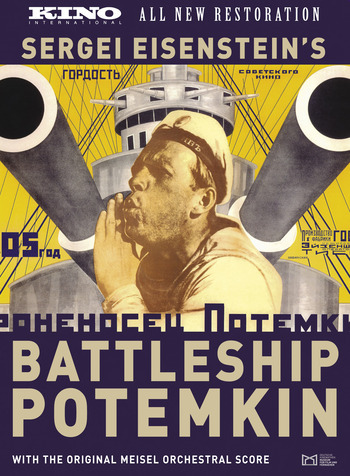
This depiction of the Russian mutiny of 1905 carries with it a heavy message, one of hope, of humanness, of fairness, and of a sense of community. It is executed, like a play, in five acts, each building on top of one another and with it the intensity of the action. Every scene galvanizes us, a true masterpiece.
The Cabinet of Dr. Caligari 🔗
1920 • Germany • Robert Wiene, Hans Janowitz, Carl Mayer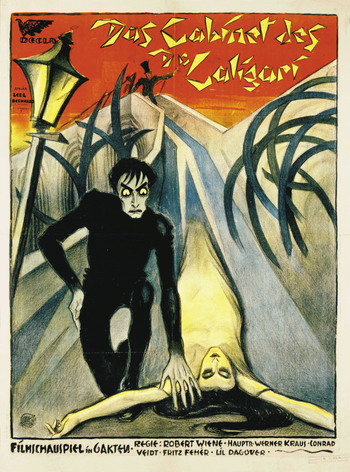
A story of inception and perception. It confuses the senses through a well-written narrative and decors that are dizzying and sharp. Nothing makes sense until the end, finally guiding the viewers through the last scene and leaving them perplexed by their own subconscious.
Sunrise: A Song of Two Humans 🔗
1927 • USA • F. W. Murnau
This story, or song, is a hidden treasure of emotions, a roller-coaster trip over the human experience where even the protagonists don't seem to be in control. The adventure is clearly defined and at each step we're visiting the extreme version of a vice or virtue. At time, we are taken aback by what is happening, were driven into the story to act for the characters, as they appear only as toys played by fate. Everything collapses and rebuilds itself in the end, a 'need for closure' realized to perfection.
Nosferatu: A Symphony of Horror 🔗
1922 • Germany • F. W. Murnau
A classic remake of the 1897 novel Dracula. The film captures the feeling of impending doom, the plague in an anthropomorphic form. It depicts what carelessness brings with it, joyous days soon being replaced by horror, and only a worthy sacrifice can balance the scale. We're reminded of this, especially during the covid-19 pandemic. The setup is classic but the acting in some part could've been better.
The Man Who Laughs 🔗
1928 • USA/Germany • Paul Leni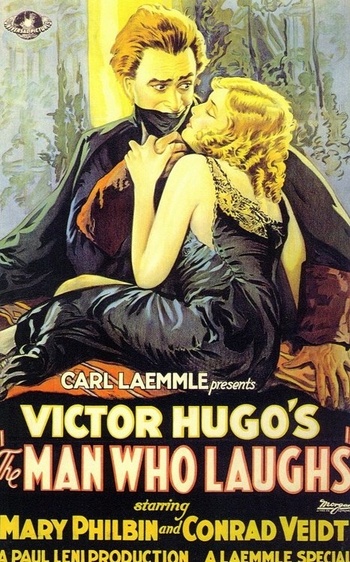
As with The Phantom of the Opera, this movie is based on the French novel by Victor Hugo. Also, similarly, it focuses on our biases, our inherent animal disgust and judgement of appearances. The movie makes you become Gwynplaine, the disfigured man, and catapults you in this unfair world where your worst attribute is also your bread-winning attribute, lost between faith and love. This is one of my favorite take on the subject, a must-watch!
The Phantom of the Opera 🔗
1925 • USA • Rupert Julian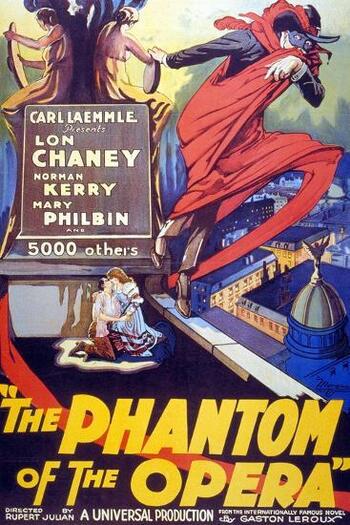
The classic story based on the French novel. The American twist on it gave it a raw aspect, focusing on the link between physical deformity and evilness. When watching it you are both stretched between having to sympathize with the Erik, the phantom, being shocked by how people treat him, and also guided by the mob that wants revenge for the senseless murder of their friends. 'If I am the phantom, it is because man's hatred has made me so.'
The Phantom Carriage (Körkarlen) 🔗
1921 • Sweden • Victor Sjöström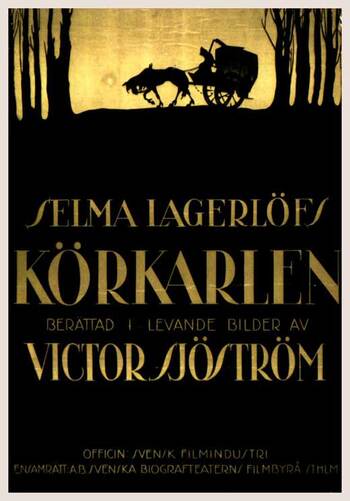
A Scrooge-, or Christmas-Carol-like story twisted to its horror limits. The Swedish cinema of the time did a good job at touching fear, not through rough gore, but through catharsis and existentialism. There's also a hint of inspiration from German expressionism of the time.
Häxan 🔗
1922 • Sweden and Denmark • Benjamin Christensen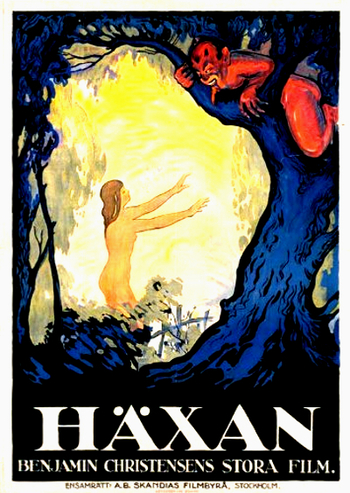
A fantastic horror-documentary on witches and the kind of thinking that makes men create them. It takes you on a journey through middle-ages folklore, forcing you to approach the topic from their angle, to then throw you back in reality by taking distance and realizing the mass psychosis.
A Man with a Movie Camera (Человек с киноаппаратом) 🔗
1929 • URSS • Dziga Vertov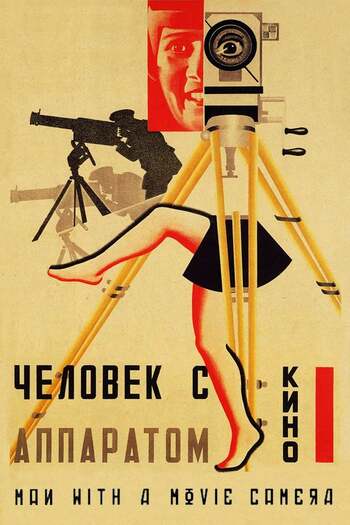
This film is one of the most captivating I've ever had the pleasure to watch. Yet, its simplicity strikes us, the purity and unprocessed bits of human life. It is filmed as a pseudo-experimental-documentary, but the juxtaposition, the arrangement of the frames, along with the different musical interpretations from later bands syncing with the rhythm, absorbs you on this exploration. So-called 'socialist realism'. Indirectly, we are compelled to build our own narrative that transcends it, to compose a poetic meaning out of what we see. A superb creation, a must-watch.